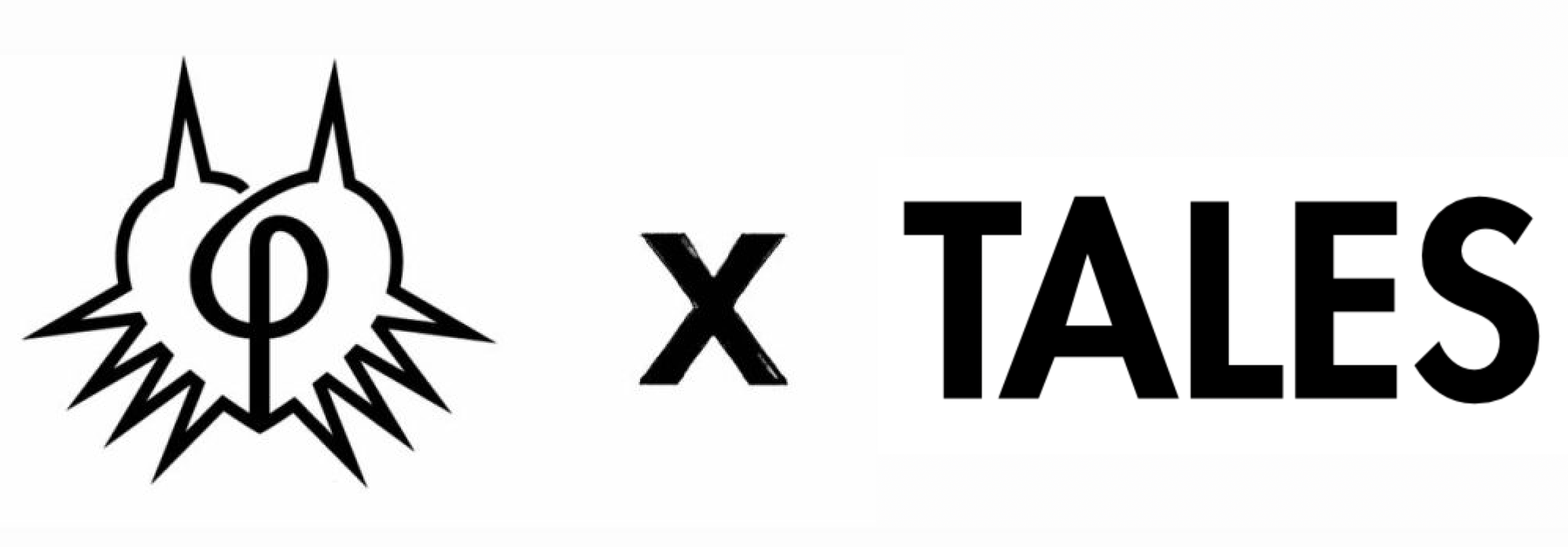
The following is an entry in Tales of Praxis, a weekly series studying the storytelling and philosophy of Bandai Namco’s Tales series through written analyses and streamed playthroughs of a wide range of the Tales games on With a Terrible Fate’s Twitch channel and YouTube channel.
I play through Tales of the Abyss as if I were an echo.[1]
(Spoiler warning for Tales of the Abyss.)
Tales games and JRPGs more broadly often concern themselves with heroes who uncover the history of their world and how a quest from the past shaped their present lives, but no matter how many times I revisit Tales of the Abyss, its particular history is uncanny because it’s more present than past. We do learn about the deep history of the world of Auldrant throughout the game, but the more pressing historical influence on our journey with Luke and the rest of his party is more recent: throughout the story, we are constantly working to catch up with, and learn the history of, the party of Van Grants and his God-Generals. The more closely I’ve looked at this core group of antagonists, the more I’ve come to see them as the party of another video game, a party that’s wrestled with fate, as many JRPG heroes do—and left us, as players, in a position to understand the contours our role in the plot, as few JRPG players can.
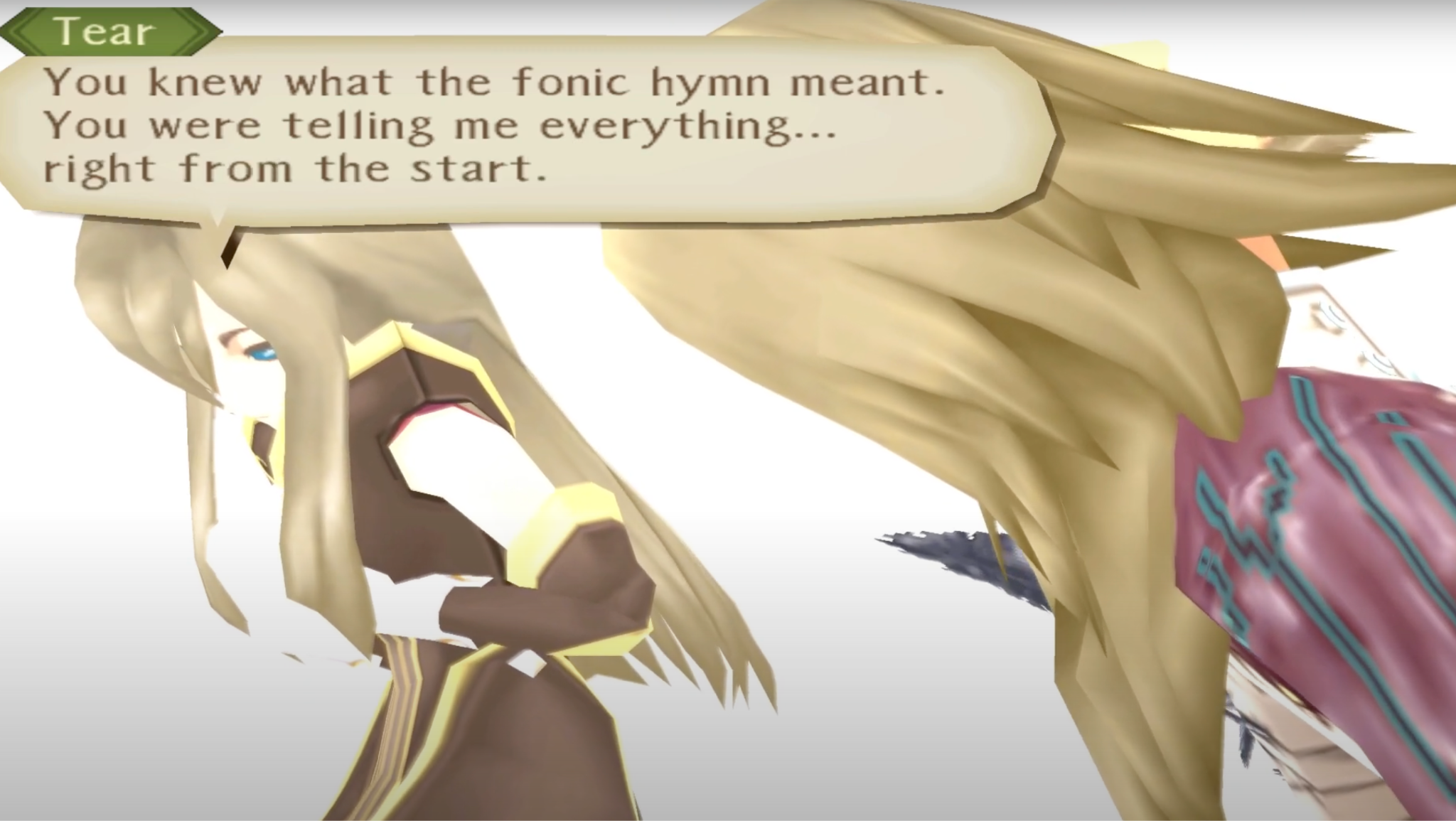
Siblings Tear and Van, descendants of the prophet Yulia, reflect on their childhood, at the end of Van’s life.
This plurality of JRPG parties in Tales of the Abyss cultivates the feeling of a strangely resonant mystery in the navigation of its plot: the kind of sublime mystery that inspires awe without suggesting a “solution” to its riddle. As I’ve tried to decipher this mystery over the years, I’ve found myself arriving, again and again, at the game’s roots in Kabbalah. Since the game’s early days, players have noticed the nominal and structural relationships between Tales of the Abyss and Kabbalah, a prominent tradition of Jewish mysticism. The planet Auldrant’s “vital points,” its seven loci of Fonic energy, are called the Sephiroth, a name that also refers in Kabbalah to the ten cosmic “vital points”: Sefirot, the emanations of God through which, from an infinite and boundless beginning, the divine perpetually creates all the realms of the universe. Several of the towns and kingdoms in Auldrant share names with specific Kabbalistic Sephiroth: Keterburg, St. Binah, Chesedonia, Hod, Da’ath, Grand Chokhmah, and Malkhuth.[2] Auldrant’s (initially) miasmatic underworld, the Qliphoth, shares its name with the immoral inversions of the Sephiroth in Kabbalah. The three higher, supernal Sefirot are also conceptually separated from the seven lower sefirot by a gulf called “the abyss.”
As I’ve struggled to make sense of my own experiences with Tales of the Abyss—with a plot to which I always seem to arrive late; with a journey whose relationship to fate and the salvation of the world remains inscrutable—these linguistic cues have encouraged me to treat the entire game as an esoteric practice: an exercise, mirroring meditative practice in Kabbalah, that provides its practitioner—the player—with an opportunity to realize spiritual resonance between herself as an individual and the universe as a whole. In that spirit, I want to offer a model for extending the Kabbalistic influence on the names in Tales of the Abyss to an interpretation of the overall game as a metaphor for Lurianic Kabbalah, rectifying the universe by harmonizing the fractured, divine emanations within it into a balanced, pure whole. By viewing the game in this light, we can understand it as a process for uniting two disparate, human urges that come to the forefront in the psyche of the player of a story-based video game: the urge to control, and the urge to discover.
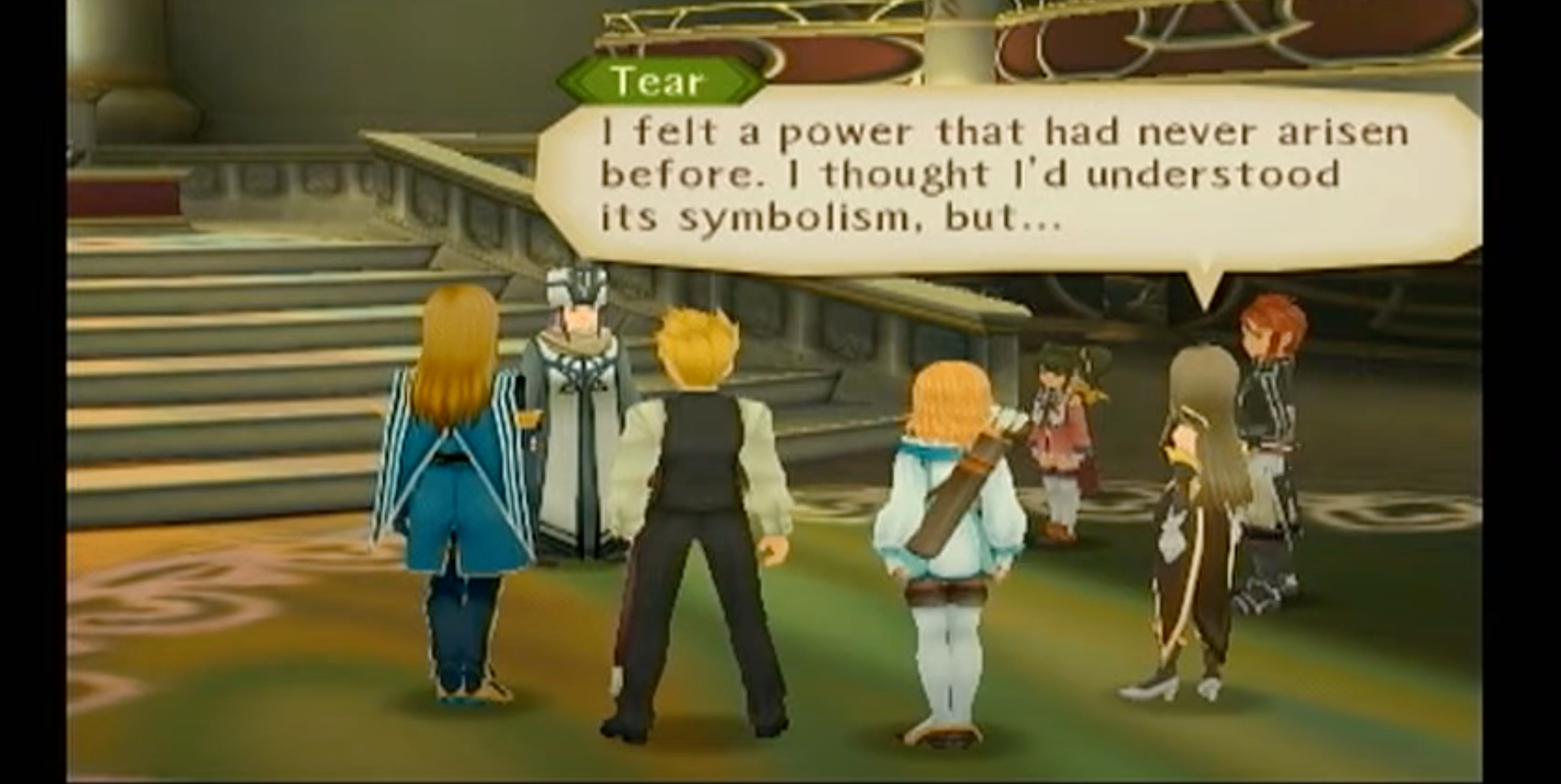
Tear deciphers the meaning of Yulia’s Fifth Fonic Hymn following her performance of a dirge at Ion’s memorial service in Daath.
I am not a scholar of Kabbalah, nor of mysticism more broadly; the portrait of Kabbalah I illustrate and apply in this study is my best effort at synthesizing the teachings made available in written, video, and online sources, together with invaluable input and feedback from friends and colleagues with more direct mystical backgrounds. The study itself is my best effort at synthesizing my experience in Tales of the Abyss, my background in the philosophy of video-game narrative, and the game’s own indications of its Kabbalistic roots in a way that makes a transcendental sense out of this notoriously difficult yet rewarding entry in the Tales series. The relationship between this game and the tradition of Kabbalah runs far deeper than similar names; if nothing else, I hope that this study offers a framework and motivation to read Tales of the Abyss in a more holistically Kabbalistic context. I hope, too, that the reader understands this study as an exploration of the special potential of an unusual video game to transform and better its player—not as an evaluation of the bona fide religious practices of any group or individual.
Video games sit at a strikingly similar conceptual crossroads to mystical traditions: in both cases, scholars and theorists have sought to illuminate the domain’s subject matter through analysis, yet in both cases, the domain offers its participants a special kind of insight, a “revelation,” that must be realized through embodied experience rather than through reasoning from premises to a conclusion. One must meditate to realize the spiritual interconnectedness at which scholarly commentary can only obliquely gesture; one must sit down and play a video game to feel the thematic totality in which its story embeds you, the active player. For this reason, this study is a proving ground not just for the Kabbalistic content of Tales of the Abyss, but also for the potential of video games to leverage their interactive form as a unique way of expressing and involving an individual in properly mystical narratives; for this reason, the ultimate test of this study’s merits cannot be reflecting on its logic at the end of a readthrough, but rather reflecting on the inner states of yourself during a playthrough of Tales of the Abyss while holding these ideas in your mind.
This study proceeds in four steps:
- I motivate the treatment of Tales of the Abyss as an esoteric text, written in such a way as to require interpretation over and above the ordinary interpretive burden which a typical work of literature places upon its audience.
- I motivate the interpretation of Tales of the Abyss’s story as a metaphor for Lurianic Kabbalah.
- I interpret the world of Auldrant as analogous to Shevirat, the cosmological stage in Lurianic Kabbalah of chaos born of divine emanations conflicting with each other, begetting immorality and free will.
- I interpret the activity of the player in Tales of the Abyss as the act of God’s finite “ray” (Kav), which made creation possible from the spiritual realm of the metaphysical, rectifying itself in relation to the immanent presence of divinity within creation (the Shekhinah, represented in the Score), with the help of the created man (Luke & Asch) balancing those divine virtues previously lost to chaos.
Ultimately, I want to suggest to you that this way of reading Tales of the Abyss helps us to understand and appreciate one of the most otherwise puzzling elements of its story: the plot doesn’t offer clear-cut resolutions to its core conflicts and its main characters’ developmental arcs, but rather invites the player to unite and harmonize herself with Lorelei, the protagonists, and the antagonists to resolve the world in a way that begets peace where once only chaos was possible.
Tales of the Abyss as an Esoteric Text
Tales of the Abyss is designed to resist, and yet demand, interpretation.
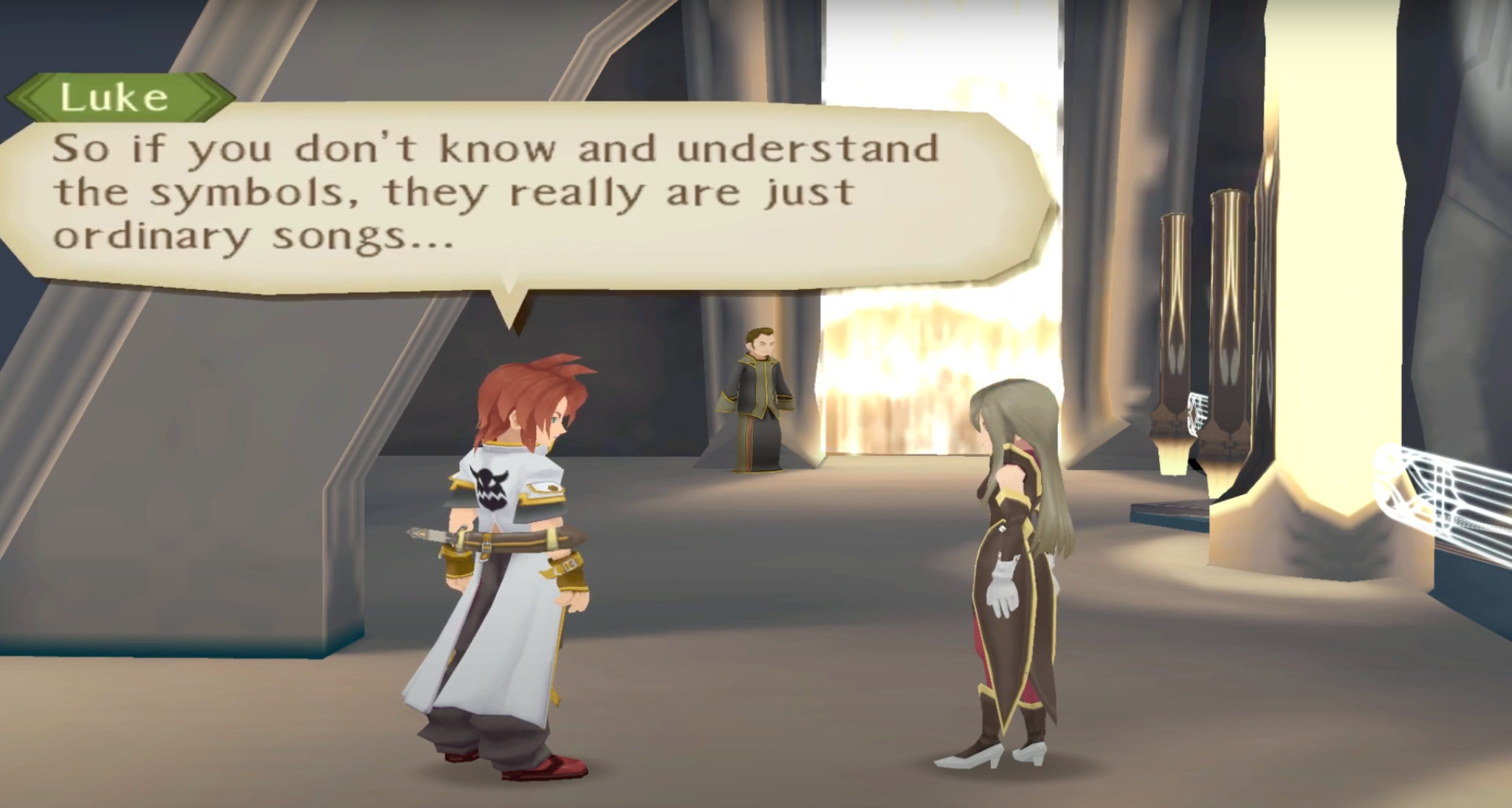
Luke and Tear discuss the nature of Yulia’s Fonic Hymns and what it takes to use them.
The world of Auldrant is deeply musical: it’s composed of (1) Fonons, “[t]he sound signals emitted by all things” and stratified into a Belt of the six elemental Fonons surrounding the planet, and (2) Memory Particles, “fragment[s] of the planet’s memory” normally contained within Auldrant’s core; thanks to Dr. Southern-Cross’s research and development in the Dawn Age, people were able to develop technology (the “Planet Storm”) to pass Memory Particles through the Fon Belt and thereby increase the amount of Fonons and energy available in the world, giving birth to a seventh type of Fonon from which those with the innate ability can read the planet’s memory of its past, present, and future. The world, therefore, literally expresses itself through sound, and those who are attuned to those sounds can discover the world’s inner nature: not just reading Audlrant’s total history (the Score) from the Seventh Fonon, as Yulia Jue did, but also reciting Fonic Hymns to channel those Seventh Fonons into potent magic—up to and including summoning Lorelei, the collective sentience of the Seventh Fonon itself.[3]
The sonic nature of the world makes possible the deciphering of its meaning, and the meaning of our place within it, through song. As with the performance of a song, though, this musical study is useless without understanding of the symbolism expressed by the music: “If you don’t understand the meaning and wisdom in [Yulia’s] hymns, they’re just songs.” Tear shows us this firsthand through her study and acquisition of Yulia’s Hymns over the course of the game: initially, despite knowing the symbols for “all but the Third and the Fifth” Fonic Hymns, she only understands, and can therefore only use, “the First and Second”; she can only come to use the other Fonic Hymns through a combination of education—uncovering the missing symbols through transmissions of knowledge from Van and Ion—and experience, leveling up as she journeys with the party and comes, implicitly, to understand the world and her place in it better. What Tales of the Abyss is motivating and describing through this Fonic basis is esoteric study: the excavation of a hidden, spiritual content within a text from its literal, intertextual, and symbolic meanings.

PaRDeS, the Hebrew word for ‘orchard’ and an acronym for the four-stage method of esoteric Torah study in Kabbalah.
Many mystic religious traditions practice this kind of esotericism, inferring systematized metaphorical content from the literal content of religious texts in order to more intimately approach, experience, and understand the relationship between man, the individual, and God, the cosmic. We saw that Tales of the Abyss already motivates a relationship between itself and Kabbalah through its nomenclature and structure; Kabbalah also provides a model for the game’s particular musical flavor of esotericism in the study of the Torah, the texts containing the word of God in the Jewish tradition. Practitioners of Kabbalah approach the study of Torah through a fourfold process described by the acronym of the Hebrew word for ‘orchard’, PaRDeS—itself a metaphor for divine secrets in rabbinical works such as the Talmud:
- ‘P’ stands for Peshat, ‘simple’, and refers to the explicit, literal content of the text.
- ‘R’ stands for Remez, ‘hint’, and refers to the meaning of a text that emerges by comparing it with other similar text from elsewhere in the Torah, related through linguistic relationships, the numerical values of words, or similar concepts.
- ‘D’ stands for Derash, ‘seek’, and refers to metaphorical or allegorical meaning drawn from the text to apply to life more broadly.
- ‘S’ stands for Sod, ‘secret’, and refers to the inner, esoteric meaning of the text, only discovered through inspiration, revelation, or other mystic insight.
When studying and interpreting a religious text, one proceeds through PaRDeS by applying a progression of various hermeneutical tools to that text. Gematria marries the meaning of words with the sums of numerical values corresponding to the Hebrew letters used in each word; the cantillation marks indicating how passages of the Torah are to be sung represent not only a means of memorization and guidance, but also an interpretive tool that illuminates the syntactic, emotional, and spiritual content of verses (one 15-note notation, for instance, occurs in only seven places throughout the Torah and expresses “emotional turmoil”—this is called shalshelet). In the pursuit of the esoteric meaning of the Torah, each individual mark of the Torah has meaning, and each can be illuminated by their relationships to other systems of meaning, whether intertextual or transcendental. Jointly, the letters of the Torah are counted in some Kabbalistic counting systems to total 600,000, which is interpreted to esoterically represent all of the souls in the world, 600,000 in total, along with 600,000 individual explanations in the Torah, each grounded in a unique soul—and each, therefore, affording each unique practitioner of Kabbalah with the opportunity and obligation to know her place in the universe according to the particular explanation of the root of her soul in the Torah.
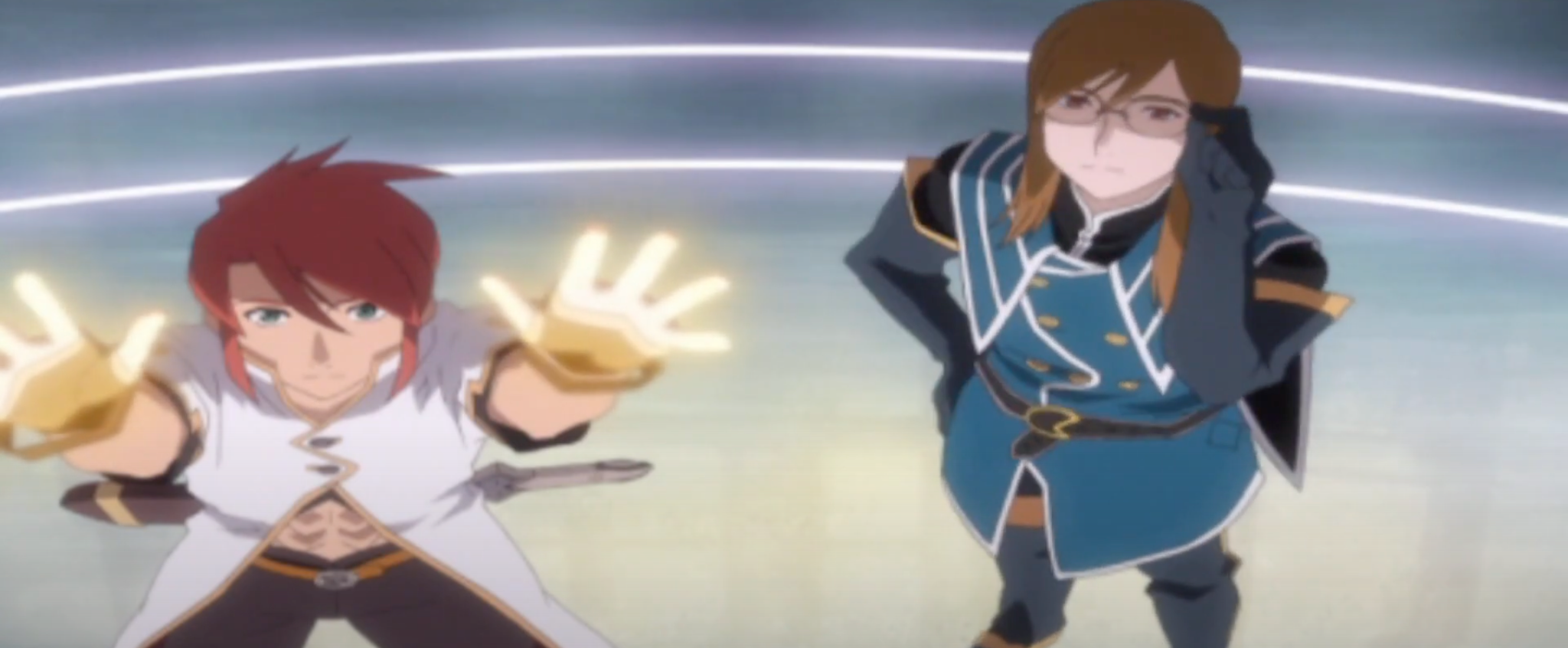
Luke works with Jade, Tear, and Asch to link the Sephiroth and safely return the Outer Lands to the Qliphoth.
Tales of the Abyss invites treatment as an esoteric text not just through the nature of the world and those within it, but also in terms of the activities through which its people come to better know the world. The quests to unlock optional artes for Guy and Jade are microcosmic esoteric journeys unto themselves: Guy’s Sigmund sword style is “a secret sword,” passed down through a series of one-on-one encounters between teachers and students from the lost city of Hod; Jade’s strongest magic is accessed by deciphering an obscure sonnet written on an ancient scroll and literally absorbing the Fonons of stones on which those same lines of text are written, hidden in places where they could only be discovered by those who uncover the deeper meanings embedded within the poem. As the Torah is jointly read, sung, and interpreted on the bimah by Jewish teachers, students, honorees, and spiritual leaders, so the rectification of the Sephiroth is a group effort between those with different, complementary affinities with the world and the Score as a whole: Tear bears the lineage of Yulia, necessary to open the way to the Sephiroth in the first place; Luke bears the isofonic relationship with the Score, the “Word” of the world, enabling him to manipulate the ancient glyphs that govern the Sephiroth; and Jade, scholar and teacher, has the scientific knowledge (Fonic Artes) and historical/linguistic understanding (Ancient Ispanian) to guide Luke’s actions in rectifying the Sephiroth. The core conflict of Tear confronting Van—two siblings bearing the lineage of Yulia, challenging each other’s ideals only to ultimately resolve their dispute through the Fonic Hymn which Van taught Tear when she was just a child—calls to mind the ethos of rabbinical debate, with students of the Torah energetically challenging each other’s views in pursuit of deeper religious understanding.
I think that a case could be made that whenever we perform “deep” literary analysis—especially when we infer what a video game’s story “says” about its player in the case of a game that doesn’t explicitly break the fourth wall—we are performing a kind of esoteric interpretation, inferring a meaning that points beyond the game’s plot and characters to express something about the player’s interactions that shape the world of a game from outside that world’s physical limits. Even with that in mind, though, I think that the specific nomenclature, metaphysics, and interpretive activities of the characters in Auldrant jointly give us special reason to treat Tales of the Abyss as an esoteric text, as if the game were promising us a deeper meaning and showing us how to find it all at once. Our task, then, is to see how far we can extend the game’s basis in Kabbalah in service of uncovering that deeper meaning—and I think that we can extend it impressively far.
Yulia and Luria: Lurianic Kabbalah and the Rectification of Auldrant
I propose that, through the name of the prophet whose readings govern Auldrant, Tales of the Abyss gives us a linguistic “hint” about how to apply Kabbalah’s concepts and practices to the game’s storytelling. Yulia Jue, reader of the Score and ancestor of Van and Tear, bears a given name that’s very close to the surname of Isaac Luria, the 16th-century Jewish mystic whose teachings and interpretation went on to form the basis of what many see as “contemporary Kabbalah.” (The inclusive distance between ‘L’ and ‘R’, the one difference in letters between the two names, is also a set of seven letters, which corresponds to the number of Fonon types that compose Auldrant, as well as the number of lower Sephiroth beneath the abyss in the Kabbalistic tree of life—along with many other semiotic cornerstones in Abrahamic traditions, such as the number of days in which God created the world.) While we don’t need to read this hint as definitive evidence of Lurianic Kabbalah’s influence on Tales of the Abyss, it invites us to explore whether this mystic tradition can shed light on the game. Once we undertake this exploration, we find that Luria’s teachings, true to mystic exegesis, do shed light on aspects of the game that might otherwise feel beyond the reach of explanation, despite being central to our experience of the story: aspects that revolve around exile and rectification.
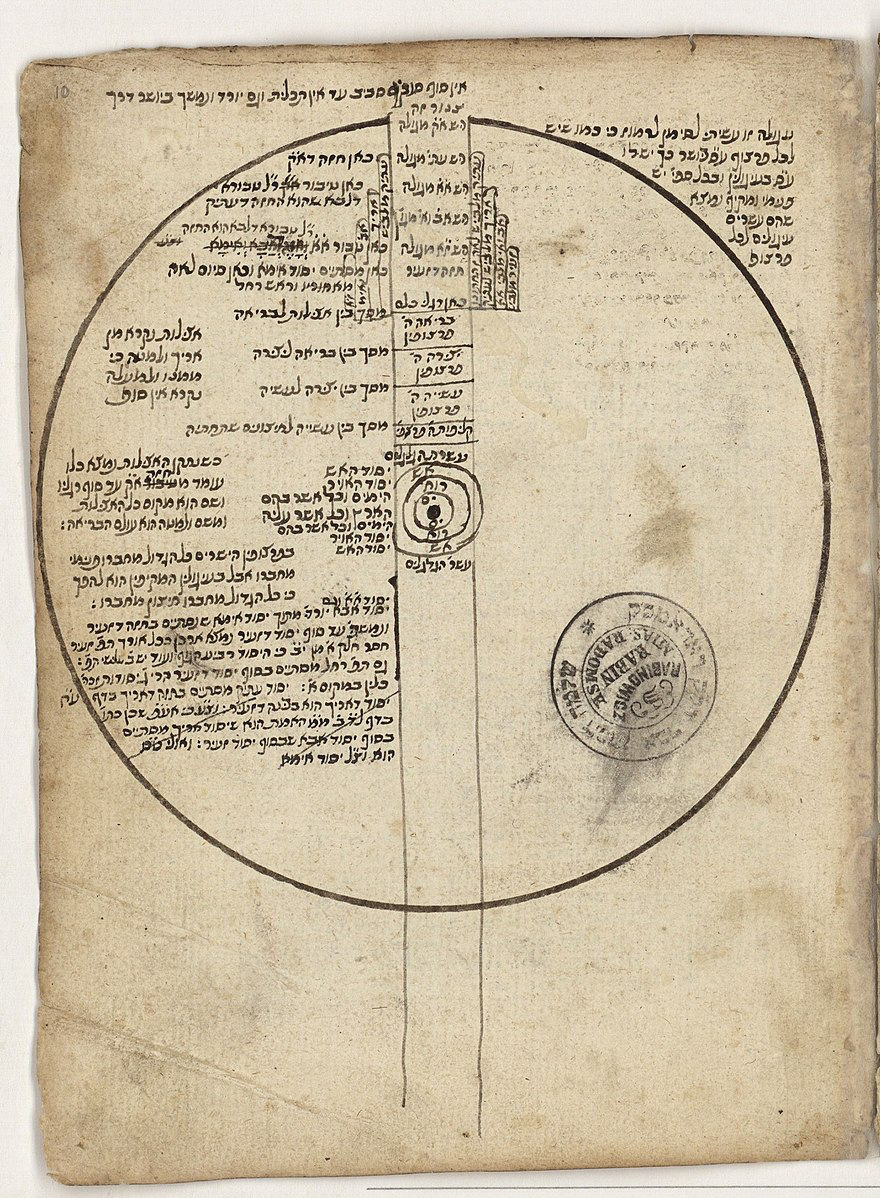
A schematic of the created worlds following the initial Tzimtzum in Lurianic Kabbalah. (Source.)
One of Luria’s major contributions to Kabbalah was the notion of an initial, primordial Tzimtzum, or “withdrawal”: a model of how the infinite, unknowable divine force from which all of creation derives—what Kabbalah calls the Ein Sof (“unending”)—exiles itself in order to metaphorically make space for the created universe. The philosophical problem which this first Tzimtzum addresses is the question of how a world of finite, independent entities can emerge out of a boundless, singular force: the Ein Sof, infinite and total as it is, would subsume any notion of differentiated existence within it, effectively “washing out” creation’s independence with its ceaseless light. According to Luria’s teachings, the Ein Sof overcame this by withdrawing its essence from a particular area, creating a kind of vacuum where the act of creation could coherently take place, with only a residue (Reshimu) left of its previous nature as part of the Ein Sof. The result is a physical world in which people are created and ensouled through a feminine divine presence, the Shekhinah, that was itself exiled and sequestered from the Ein Sof in the very process of creation—calling out for a return from exile that is only possible through the mystical and ethical practices of humans.
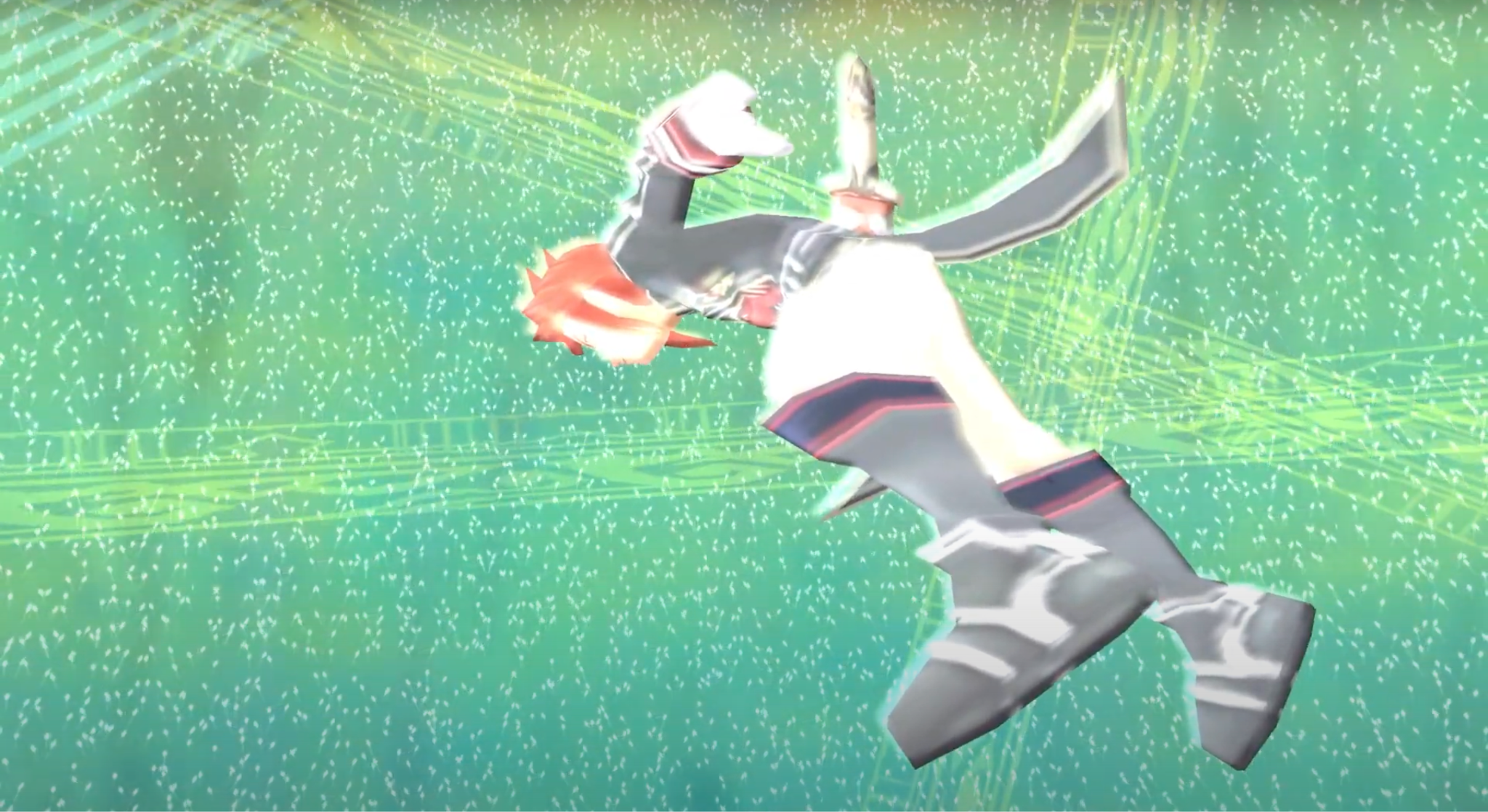
Luke’s consciousness projected into the core of Auldrant after closing the Absorption Gate.
This kind of exile-through-spatial-partitioning colors Auldrant at all levels. Initially, the planet’s memory is bound within its core, and Lorelei, the aggregate sentience of the Seventh Fonon, is similarly bound within the core for the majority of Tales of the Abyss’ plot—as though the total history of the world were withdrawn in order to make space for humanity and free will in the created world, just like the initial, primordial Tzimtum taught by Luria. Yuria’s plan to raise the world’s surface and create the Outer Lands in concert with the Sephiroth Trees, in order for humanity to survive the miasma, similarly makes space for the development of the human world through exile and distance from the core—an echo of the infinite, progressive withdrawals according to which successive spiritual realms unfold from the Ein Sof, all the way down to the physical universe and humanity. Lurianic Kabbalah sees the spiritual downfall and redemption the cosmos played out within, and crucially dependent upon, the lives and souls of individual humans within the created world, particularly those distinctly prophetic, messianic, or otherwise spiritually attuned individuals whose embodied actions within the physical world overcome a personal exile in pursuit of harmony that propagates from their personal communities through the broader spiritual cosmology (e.g., Abraham, Moses, Elijah and Enoch); just so, the first act of Tales of the Abyss ends with Luke (whom we will come to read as one aspect of Auldrant’s messianic figure, below) being exiled from his friends, family, and home following his fall from grace in the destruction of Akzeriuth, and Luke’s own creation seven years earlier begat the exile of Asch from his own family and home.
In the Lurianic picture of creation, the Ein Sof focuses its light into a limited ray, the Kav, to extend into the vacuum it created in the first Tzimtzum. Each of the ten Sefirot—acting independently from each other, held in immature metaphysical vessels—represents a particular emanation of the divine, and constitutes the created realms as the Kav fills those Sefirot, one after the other. This lack of harmony between the Sefirot led to those Sefirot further from the Kav’s origin in the Ein Sof (Binah through Yesod) shattering under the force of the divine light, with fragments of those shattered Sefirot descending, themselves “exiled,” into the created world, begetting Qliphoth, the immoral antitheses of the divine emanations represented by the Sefirot. From this state of chaos (Tohu), the universe evolves to a state of rectification (Tikun), repairing its fractured state by harmonizing the previously siloed Sefirot with each other and configuring them into Partzufim, “divine personas” that represent different aspects of the divine and enclothe each of the ten Sefirot within each individual Sefira (e.g., the six emotional attributes represented in the Sefirot of Chesed, Gevurah, Tiferet, Netzach, Hod, and Yesod are rectified and harmonized in the Partzuf of Zeir Anpin (“Small Face”)). Humans—in the lower, created physical world, distanced from their divine origin yet surrounded by the exiled Shekhinah and shattered sparks of divinity—have the free will, and the ethical obligation, to actively effect this rectification by observing the 613 Mitzvot, redeeming the physical world and ascending through the Sefirot to rectify their own relationship and identity with the divine totality of the universe—crucially depending upon, rather than erasing, their independent agency in the process.
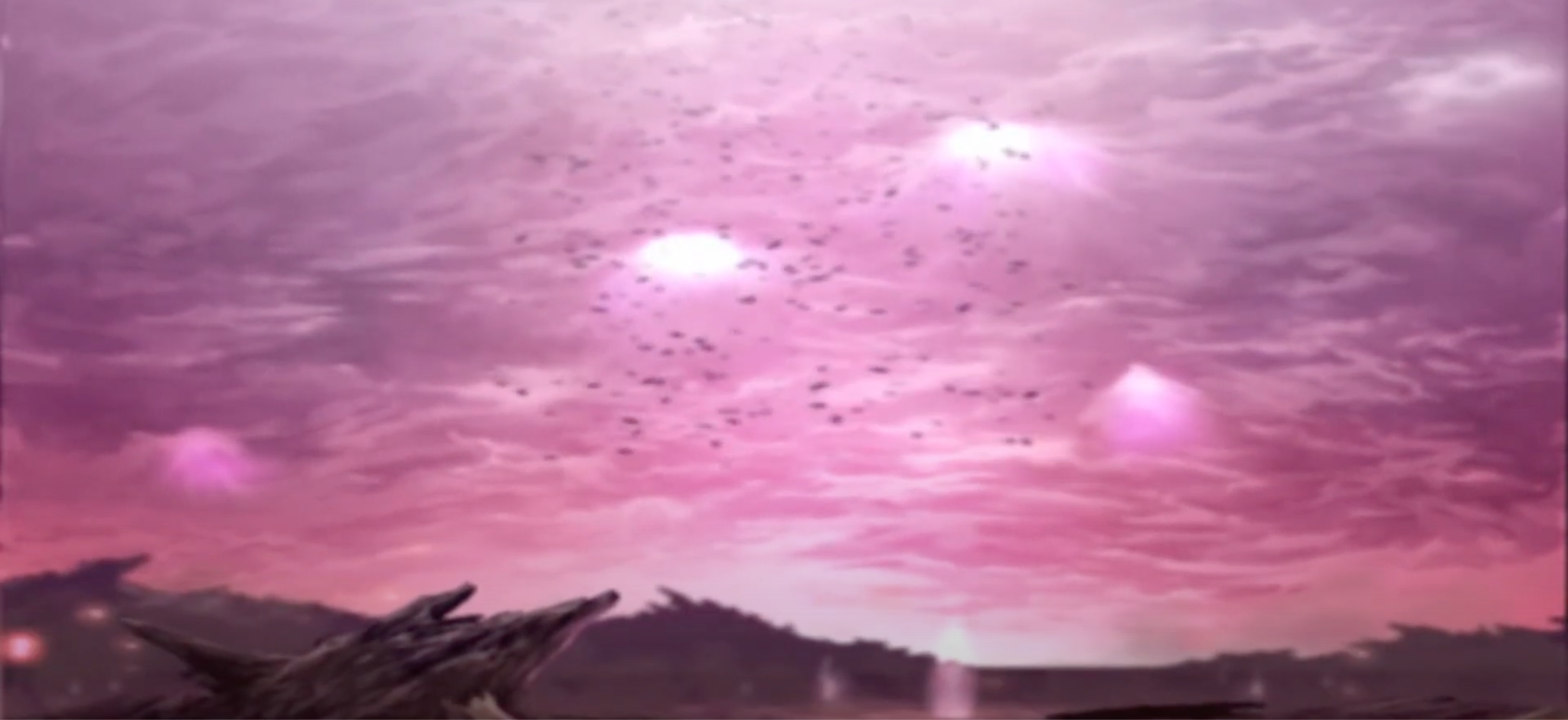
The view of the Qliphoth nested beneath the Outer Lands in Auldrant, as experienced by Luke and the rest of the party at the moment of Akzeriuth’s collapse.
The Qliphoth in Auldrant cries out for this same kind of rectification at the start of Tales of the Abyss: the “development” of human civilization—in the form of the Planet Storm (designed to make more energy available through the Sephiroth), and Fonic machinery straining that Planet Storm during the Fonic War—led to the emission of noxious miasma from the vibrating core of the planet, introducing a chronic toxin from contaminated Seventh Fonons—not unlike a toxic consequence of an overpowering divine light, shattering the cosmic balance. As Luria showed practitioners of Kabbalah how to rectify the physical and spiritual world by harmonizing the Sefirot into the Partzufim, so Yulia showed her followers—those who would sew the seeds of the Order of Lorelei—how to rectify their world by using the Sephiroth Trees to elevate the planet’s crust above the miasma, creating the Outer Lands and distinguishing it from the Qliphoth.
But Luria’s teaching did not intrinsically redeem humanity, and Yulia’s reordering of Auldrant did not intrinsically redeem its people: in each case, people were merely provided with a path, a model of understanding, through which they could choose to apprehend the divine residue around them and work to rectify themselves through ethical action and spiritual contemplation. In fact, the very incompleteness of Yulia’s solution to humanity’s plight esoterically prefigures the path to salvation which Luke, his friends, and the player must walk throughout the plot of Tales of the Abyss: the elevation of civilization to the Outer Lands distances people from the miasma, but it also distances them from Lorelei, the planet’s memory, that exiled divine presence which must be integrated and redeemed in order for spiritual order to be realized throughout the cosmos. A tectonic reorganization of people’s relationship with the world can redeem humanity no more than an analytical restructuring of Kabbalistic metaphysics can: each is only a preamble to the embodied actions of Luke, of spiritually apt leaders, bringing a well-positioned and prepared humanity to face their moral failings, their Qliphoth, in order to ultimately overcome them and embrace the divinity within and without the world.
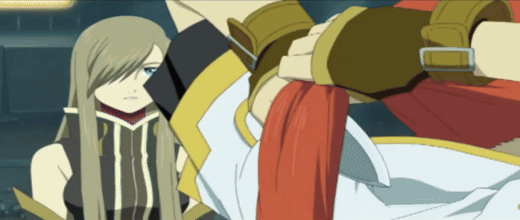
Luke cuts his hair to demonstrate his newfound ethical resolve, a gesture evoking the Jewish ritual of upsherin.
This is the spirit of individual resolve exemplified in Luke’s ritualistic gesture of cutting off the long hair on the back of his head after destroying Akzeriuth, being exiled from his friends, and resolving to enact a new commitment to personal responsibility. This act—cutting his long hair in preparation to determine his place in the world, while preserving the two long locks in front of his ears (his peyot)—distinctly evokes the Jewish tradition of upsherin, when a boy’s long hair is cut for the first time at the age of three: preserving the peyot that mystically link one’s suprarational consciousness with one’s subconscious mind, and cutting the rest of the hair to prepare him to form his conscious, rational identity with the physical world outside himself. (It’s true that Luke is seven years old when he commits this act, but the extent to which he was isolated in the fon Fabres’ manor for those seven years makes it easy to read him as developmentally similar to a three-year-old—and don’t forget the mystical meaning we already derived in the number seven according to the Sefirot, Genesis, and the linguistic relationship between Luria and Yulia, above.)
Luke learns that rectification must begin on the personal level, but personal rectification cannot be realized without the interpersonal: enclothing our own identities in those to whom we are related, as the Partzufim enclothe the Sefirot in one another. It’s in this pursuit of seeing ourselves in the other—and using that unity to ascend the broader spiritual ladder—that Kabbalah illuminates the echoing nature of Tales of the Abyss’ plot: creating a mystic puzzle box by setting us, the player and party, on a journey to follow in the footsteps of our other halves, as though we were an echo.
Shevirat: Reading Van and the God-Generals’ Philosophy as a State of Tohu
Tales of the Abyss is the story of restoring Hod by defeating the One Who Would Seize Hod.
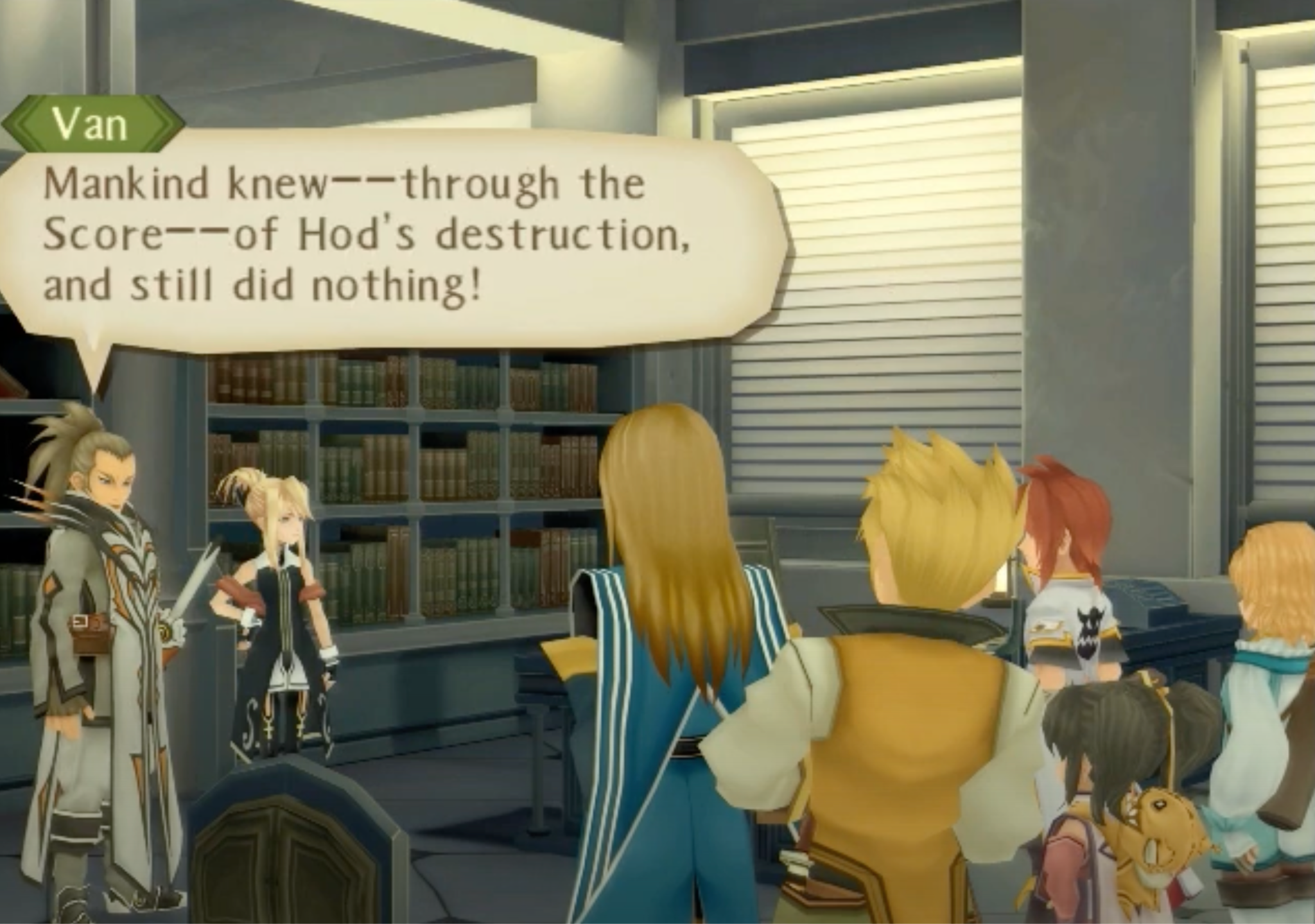
Van tells Guy that humanity allowed their homeland of Hod to perish because of the Score.
Our ultimate enemy in the game, Van Grants, is less of a final boss than he is an esoteric puzzle. His name alone, ‘Vandesdelca’, is an exegetical exercise that ties him to the game’s plot, themes, and spiritual registers: in Ancient Ispanian, the primordial language that appears in Fontech such as the glyphs that govern the Sephiroth, it means ‘one who would seize glory’, a moniker which Lorelei itself uses to refer to Van’s plot to capture and destroy Lorelei. The meaning of this still isn’t self-evident, though: while Van has grand designs on reshaping the entire world according to his preferred philosophy, those efforts don’t seem to be in pursuit of “glory” in the way that, say, trying to become a hero or ruler of the world would be to seize glory. The meaning becomes clearer when we apply another layer of interpretation beyond the game: in Kabbalah, the eighth Sefira is Hod: הוֹד, Hebrew for glory.
Esotericism, then, allows us to grasp the meaning of Van’s character as one who would seize Hod, which has a much more transparent meaning to those who have played the game: Van’s vendetta against the Score began when Malkuth’s experiments on him caused him to activate an artificial hyperresonance and destroy his homeland of Hod by destroying the Sephiroth Tree supporting it; Van’s ultimate headquarters from which he sets out to create a replica world, at the cost of the original, is Eldrant, a replica of Hod. Our inferential path to arriving at this meaning, though, also suggests a more metaphorical content to Van’s identity that situates his character arc within the broader context of a world that is shattered in the Lurianic sense of Shevirat: the state of the universe after the Sefirot’s vessels have fragmented, at which point the work of rectification must begin.
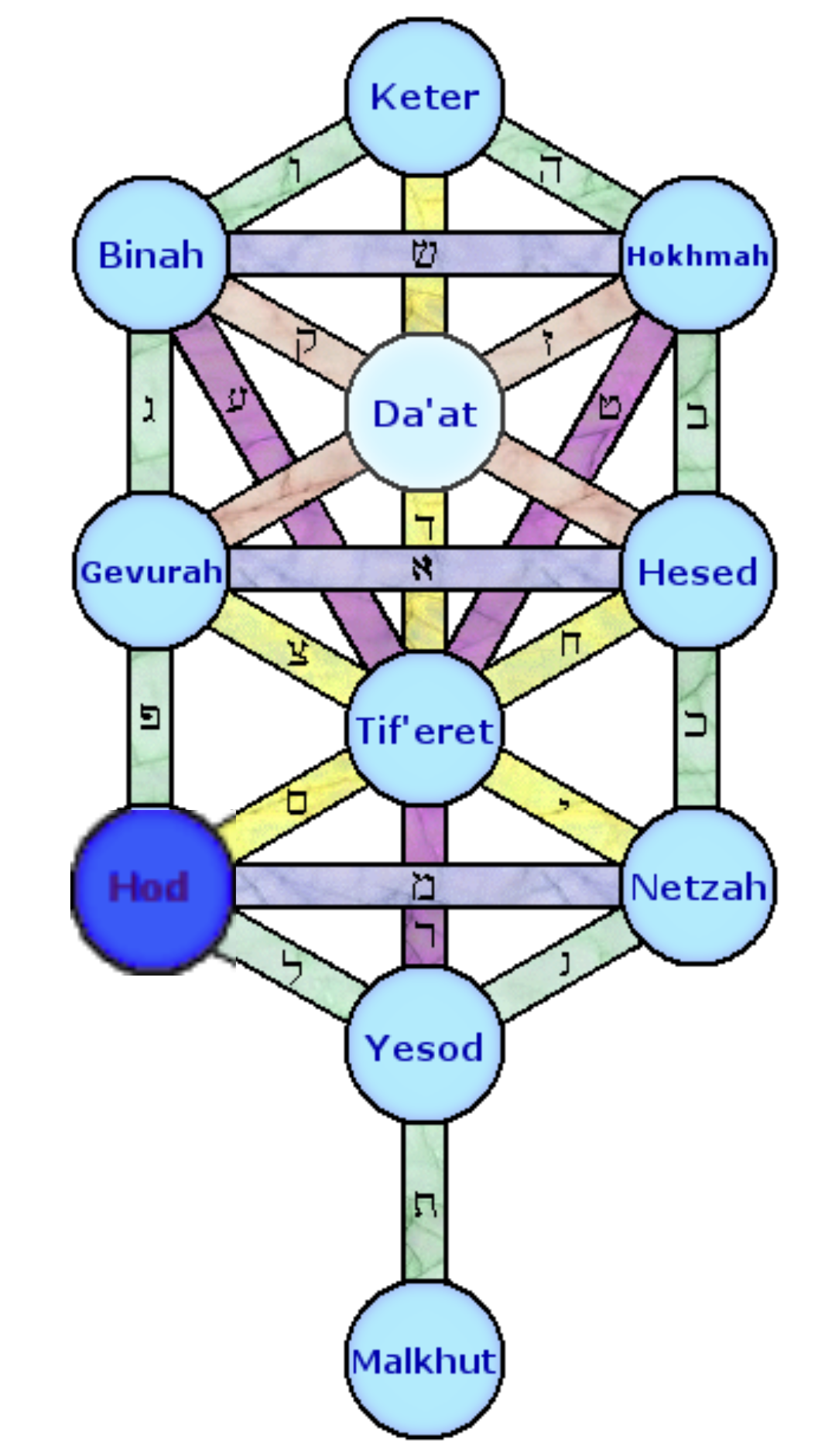
Hod, the eighth Sefira in Kabbalah. (Source.)
In Kabbalah, Hod is associated with conscious submission to the divine power that animates the world and oneself. The prophet’s ability to see the future is associated with Hod, yet the root of evil is also grounded in Hod: humankind’s free will also makes it possible that they might misinterpret the future trajectory apprehended through divine revelation, or that they might submit to idols rather than the actual divine in a misdirection of Hod (as in the story of the biblical Aaron, Kabbalistically associated with Hod, inadvertently enabling the worship of the golden calf (Exodus 32)). Hod, in other words, captures the tension between the possibility of free will, as the Ein Sof made possible through the first Tzimtzum, and the revelation of oneself as part of a unified, divine cosmos, consonant with the divine will’s intentions for the past, present, and future course of creation. It captures the tension between pluralistic self-determination and a unitary destiny. In Van, therefore, we see the root of Tales of the Abyss’ perspective on cosmic rectification: such rectification can only begin once the personal ego is set aside as the final ends of our actions, reconceived as an instrument through which we can harmonize ourselves with the broader world. One who would seize Hod and attempt to subordinate the cosmos to his own narrowly-construed personal will is thus the absolutely primary obstacle—and, indeed, the “final boss”—to overcome before the universe can heal.
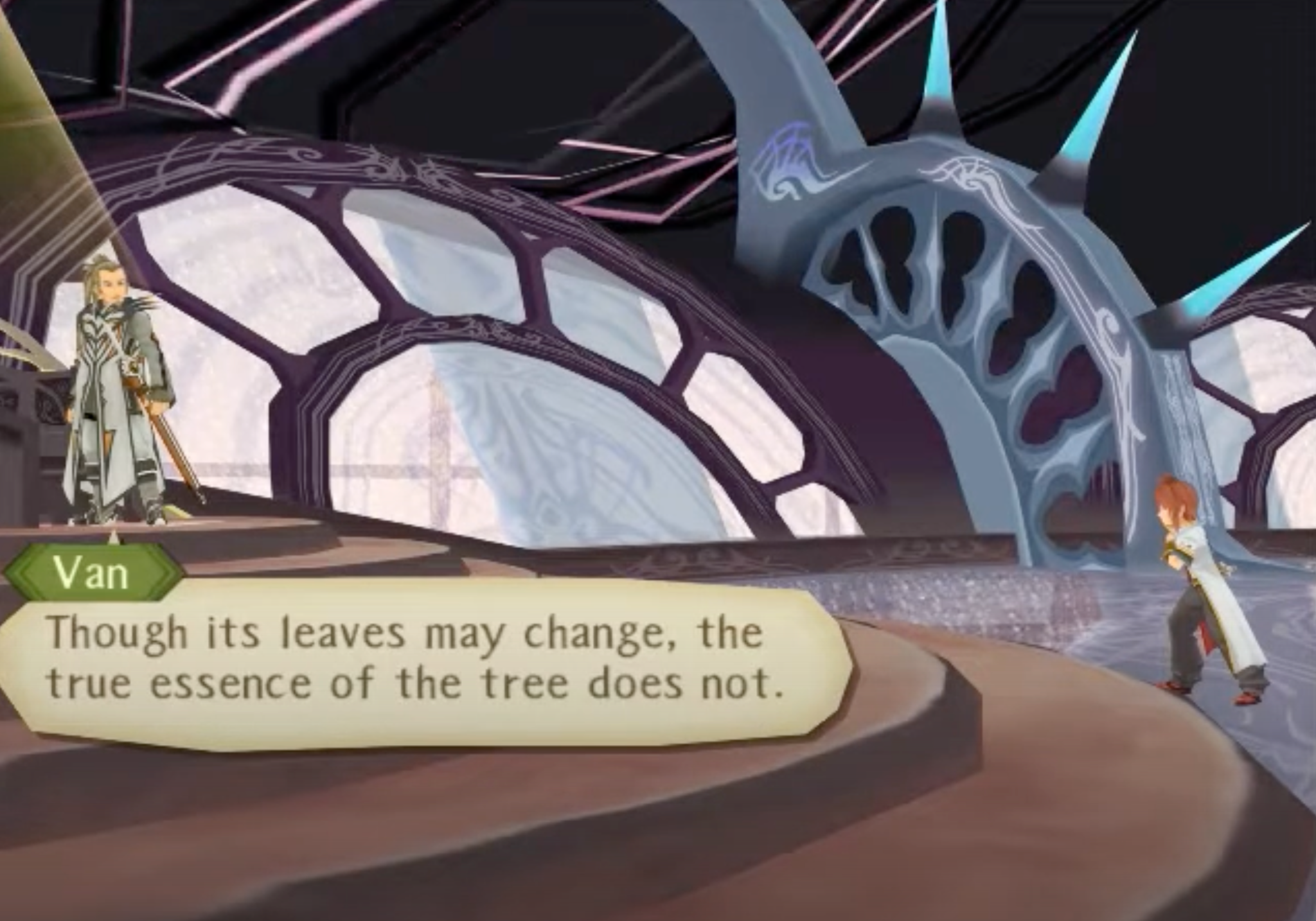
Van opines on the inescapable, enervating nature of the Score, before his organ at the Absorption Gate.
Van’s relationship with the Score illustrates what it means to be a person who “would seize Hod,” would seize that sense of destiny that is ultimately, by definition, beyond one’s capacity for independent agency. Van was forced to literally destroy Hod and imbalance the Sephiroth through which the Outer Lands were supported; once he learns that this was written and known in the Score, he becomes obsessed with a false understanding of “rectifying” the world by destroying the Score, annihilating the very composition according to which human history and community are harmonized across time. Van claims that his goal is to “free humanity from the Score and give it a way to survive,” but he pursues this in the self-undermining way we would expect of someone who tries to seize control of that virtue that is only attainable by submitting to something greater than oneself: in his effort to resist and reshape the universe of which he is a part, he only ends up threatening to further shatter that universe by rejecting its nature in favor of artifice, rejecting original humans in favor of Replicas untethered to the Score.

Van, releasing the energy of Lorelei after imprisoning the aggregate sentience of the Seventh Fonon within himself.
I feel as though Luke, the party, and I—the player—were echoes resounding through the story of Tales of the Abyss because Van and his cohort strike me as a party of video-game avatars who discovered the limits of their agency and railed against those limitations. An esoteric reading of Van further reinforces this impression: within a video game—a system according to which the actions of characters and the history of the world are determined by the agency of an unknowable, unreachable Player beyond that world—Van rails against the inability of characters to chart their own destinies, and his solution to this problem is binding Lorelei, the sentience of Plot itself, within his being. It is as if an avatar were trying to govern himself by absorbing the player, eliminating the distinction between them by force and subterfuge. Compounding this impression is the fact that the scenario writer for Tales of the Abyss, Takumi Miyajima, reportedly had initially wanted Van to be a playable character in the game prior to Luke’s destruction of Akzeriuth. That he was an intended avatar who ended up acting as an NPC reinforces the idea that this would-be hero desperately tried to assert his autonomy by absorbing the very concept of destiny—though of course, this effort is transparently and tragically futile when presented in a video game, where Van has failed to absorb the flesh-and-blood player who actually effects the progression of the game’s plot.
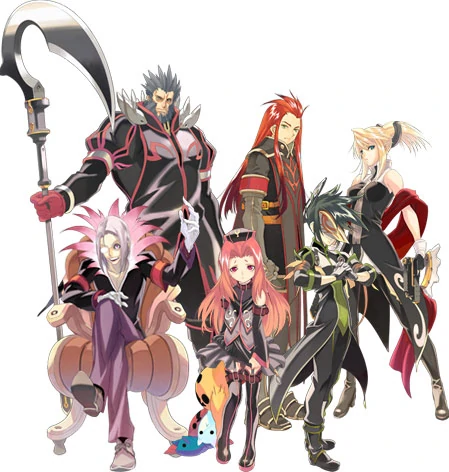
Official artwork of the six God-Generals. (Source.)
The God-Generals fill out the rest of Commandant Grants’ “JRPG anti-party,” with a plurality of reasons to resent and resist the roles in which the Score cast them:
- Largo saw his daughter repossessed by the Kimlasca-Lanvaldear royal family and his wife subsequently lost to suicide at the behest of the Score.
- Arietta’s home, the Isle of Feres, was lost—along with her parents—to the tidal waves that followed the destruction of Hod.
- Sync was left bereft of purpose after being created to fill a role he could not: that of Fon Master, a replacement for the original Ion.
- Legretta lost her brother, Marcel, due to his service in a battle led by Van, which Van knew—from the Closed Score—would end in defeat.
- Asch was bound to a role of heroism within the Score and kidnapped by Van for the purpose of overturning the Score.
- Dist, along with Jade, lost his beloved childhood teacher, and dedicated his life to research into technologies through which he could oppose the planned trajectory of the universe by replicating or otherwise recreating her.
Van’s machinations with the God-Generals are a provocative model not only for how a group of self-aware JRPG heroes might reject their fated history, but also for how a group of tormented people with an obfuscated spiritual understanding would further exile themselves from spiritual unity in a misguided attempt to save themselves. Asch, the original “light of the sacred flame,” is cast as a messianic figure in the Score: promised to lead his people and the world to the prosperity offered by (part of) Yulia’s Score, and sharing his Fonon frequency with Lorelei itself, fundamentally aligned with the Planet’s memory and destiny. How clever, then, to try to trick fate with sleight of hand, replacing Asch with a Replica, Luke, who is functionally identical yet has a different soul, a different perspective within the universe, than his messianic original. With the universe “deceived,” Van and his God-Generals recede into artificial identities—the God-Generals adopting new names,[4] Van posing as Luke’s teacher and a leading figure in the Order of Lorelei—until they can covertly enact their plan of (1) collapsing the Sephiroth Trees to sink the Outer Lands, (2) taking advantage of surplus Seventh Fonons to generate Replicas of Auldrant and its people, and (3) using Asch’s hyperresonance to annihilate Lorelei, binding the remaining Seventh Fonons to the Replicas (a fitting symbol for trying to empower individuals to determine their own destinies, by destroying the external determinant of fate and binding the remaining particles that made fate possible to the individuals instead).
The otherwise mystifying fictional military rank of “God-General” gets an explanation on this level of interpretation: in a world where Lorelei, the Score, is treated as the one true god, Van’s generals conspire to seize their own agency and become as gods in their own right—a metaphorical echo of Van literally taking Lorelei into his own body.
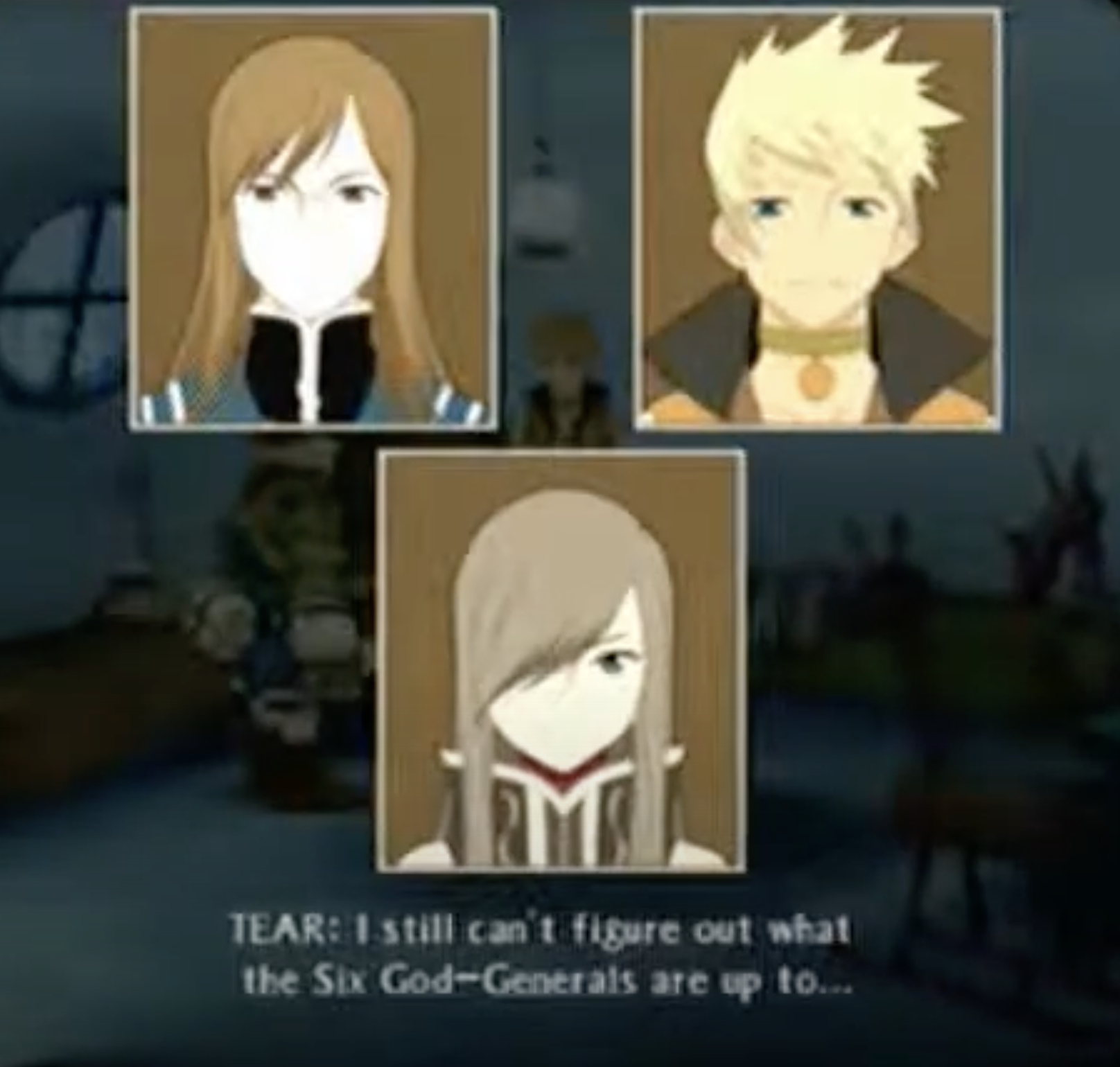
Tear struggles to understand the God-Generals’ plans as the party heads to the Zao Ruins to rescue Ion from them.
The result of this scheme is that Van and the God-Generals lurk outside the spotlight of Tales of the Abyss’ story: from the earliest motions of the plot onward, Luke and the party feel as if they were chasing the shadows of a group they don’t understand. They repeatedly draw the bad inference that various God-Generals (and Van) have died after their battles with them, only to see those villains reemerge along with their machinations; they spend major chapters of the game trying to catch up with Asch, or find Sync to uncover his role in the New Order of Lorelei, rather than enacting their own plans and forcing the God-Generals to react. Some God-Generals even remain obscure following the conclusion of the game’s main story: Legretta’s loss of her brother and relationship with Van are only clarified if the player goes out of her way to find a sequence of optional training sequences between Tear and Luke, and subsequently discovers Legretta’s letter to Tear, left by Van’s grave in Yulia City; the depth of Dist’s obsession with reviving Nebilim through Fomicry research—and, indeed, the mere fact that Dist remains alive at the end of the main plot—is only revealed if the player undergoes the most challenging and complicated optional content at the end of the game, falling into Dist’s plot to reconstitute Nebilim through the Fonons of the Planetary Arte Catalysts and discovering his hidden Fomicry lab where he bred and imprisoned his most monstrous replicas. As a player, I feel the esotericism of the game—its magnetic pull drawing me to a meaning beyond its main plot—because the antagonists (very much like Satan and other antagonistic forces in esoteric religious texts[5]) are fundamentally characters that have gone out of their way to place themselves outside of that main plot, ironically evoking the text’s hidden meaning exactly by acting in such a way as to divorce themselves from the spiritual redemption it portends.
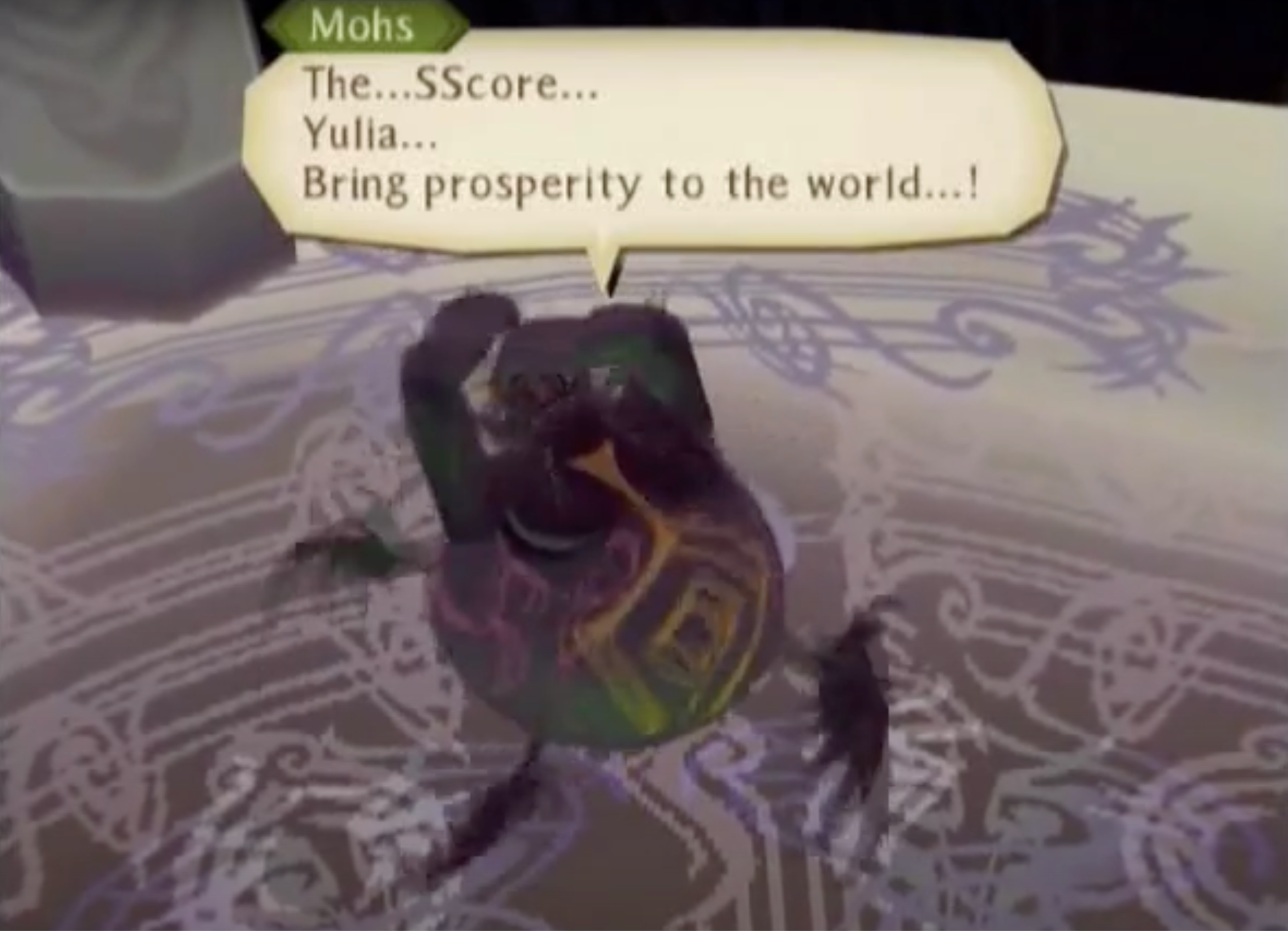
Mohs in his final, corrupted form: a slave to the Score until the bitter end.
Try as they might, Van and the God-Generals don’t escape the story of the world, nor the memories of Auldrant: our journey with Luke and his friends discovers them, exposes them, and rectifies them, making esoteric meaning out of their very attempt to escape the spiritual order of the universe. In this sense, though they initially seem so antithetical to him, these leading villains share their fatal flaw with Grand Maestro Mohs: they all misunderstand the relationship between their individual place in the world and the role of the Score in the world. Mohs takes the letter of the Score’s literal meaning to be the final authority in the history of the world, using every resource available in order to enact the “promised” war between Kimlasca-Lanvaldear and Malkuth; yet the tragic irony of Mohs, as we see in his ultimate demise, is that he has no facility for actually understanding the content of the Score, so much so that his exposure to Seventh Fonons (the “source code” of the Score) contaminates his mind and erodes his rational faculties into dust. Though Van and his cohort seem to understand the Score better than Mohs and manipulate him to serve their own ends, I think that the esoteric model of exegesis shows us how their notion of the Score is just as inadequate as Mohs’, albeit on a different level.
Recall Kabbalah’s framework of PaRDeS: the interpretive ladder from literal meaning, to intertextual meaning, to metaphorical meaning, to esoteric meaning. Mohs is trapped in peshat, the explicit content of the Score’s text; Van and the God-Generals, I think, are trapped in remez. They see the intertextual relationships between various elements of the Score and the interpretations according to which people govern their lives by the Score (as in Van’s example of the Score telling someone, “If you walk to the east, you shall discover great riches,” and thereby getting them addicted to it as a predictive and semiotic tool in that person’s life). From this perspective, it’s easy to feel the indignation common amongst Van and his lieutenants: an intertextual understanding of the Score explains and provides a cipher for the meaning of all history, even as found in other “texts” not literally related to the Score (battle plans, daily schedules, political maneuvers, etc.), and yet it makes no place for individual agency within the created world. If the source of the universe’s meaning is based in text and prophecy we did not create, then our own creative impulse—that activity which would otherwise allow us to determine ourselves—is subordinated to those external sources, as Van & co. have routinely experienced when their lives were uprooted in service of a homogeneous world culture, in service of Yulia’s prophecy.
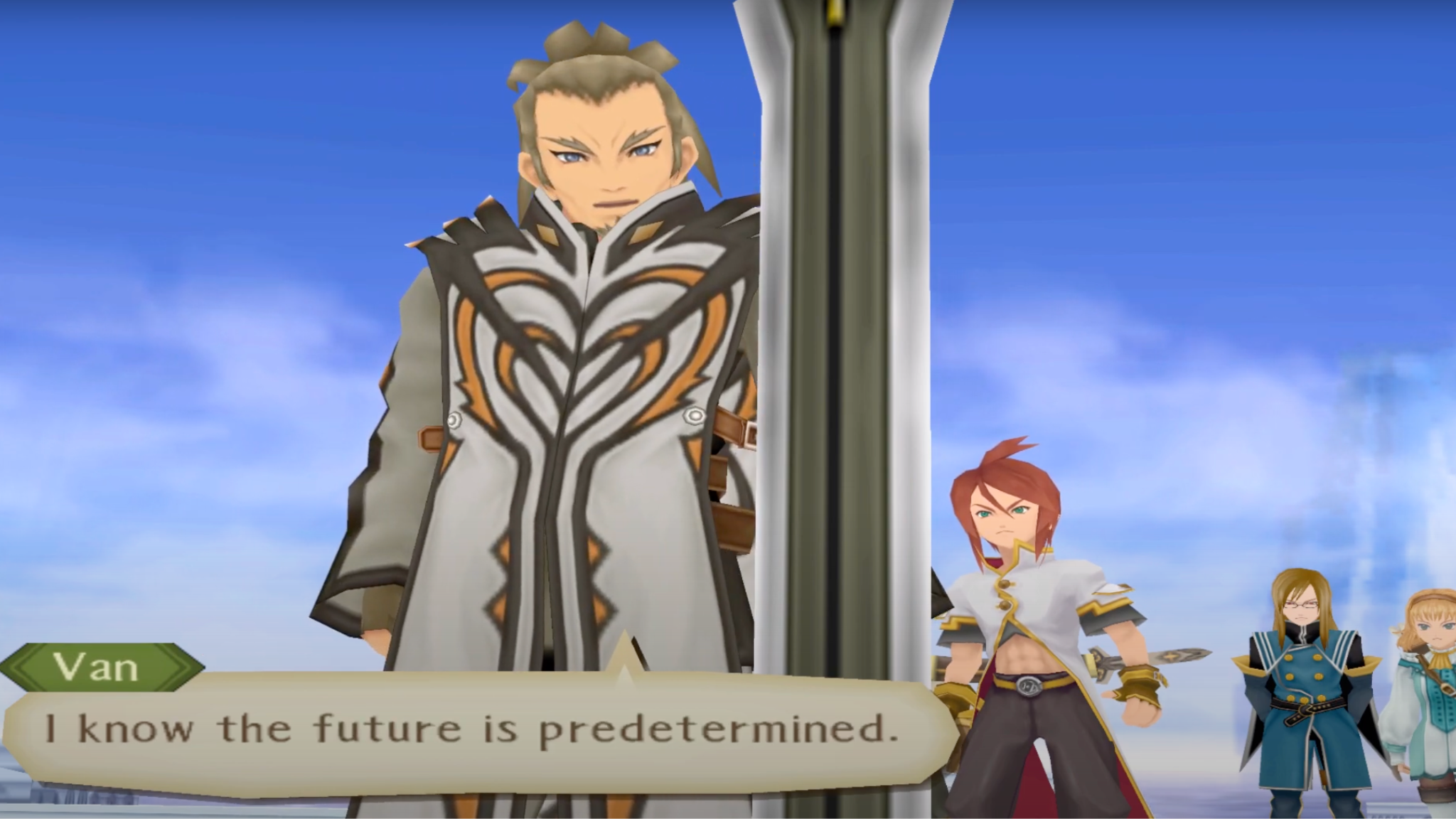
Van articulates his core metaphysical belief before his final confrontation with Luke and the rest of the party.
When we interpret the God-Generals as hermeneutically limited in their perspective on the Score, the initial scenario motivating Tales of the Abyss’ plot comes into focus as a state of Tohu in Lurianic Kabbalah: a chaos in which those aspects of the universe that ought to interrelate and mutually support each other are instead too immature to recognize and support this spiritual understanding, instead shattering and falling further from their divine origins. Like the immature Sefirot vessels, the God-Generals are each bound up in their own personal history of the world, unable to authentically see and support each other in the way that an actual JRPG party (like Luke and his friends) would—unable to spiritually enclothe themselves in each other’s interests, like the mature Sefirot, organized into Partzufim, can. By attempting to destroy the Score—the core “text” of Auldrant, and the cosmic layer that makes possible the interpretation of individuals relative to the world’s overall trajectory—they literally collapse the Sephiroth Trees and threaten to sink the world of humanity into the Qliphoth, metaphorically divorcing humanity from its roots in the broader ecosystem of the cosmos. In their effort to seize Hod and determine their destiny on a purely personal level, they purge humanity of any sense of history, community, and fate: those who are seemingly “free” from the Score, the Replicas, are also those who are most demonstrably lost, with no place to call home—only familiar to other characters in the context of their doppelgängers, those originals whose purpose they failed to inherit.
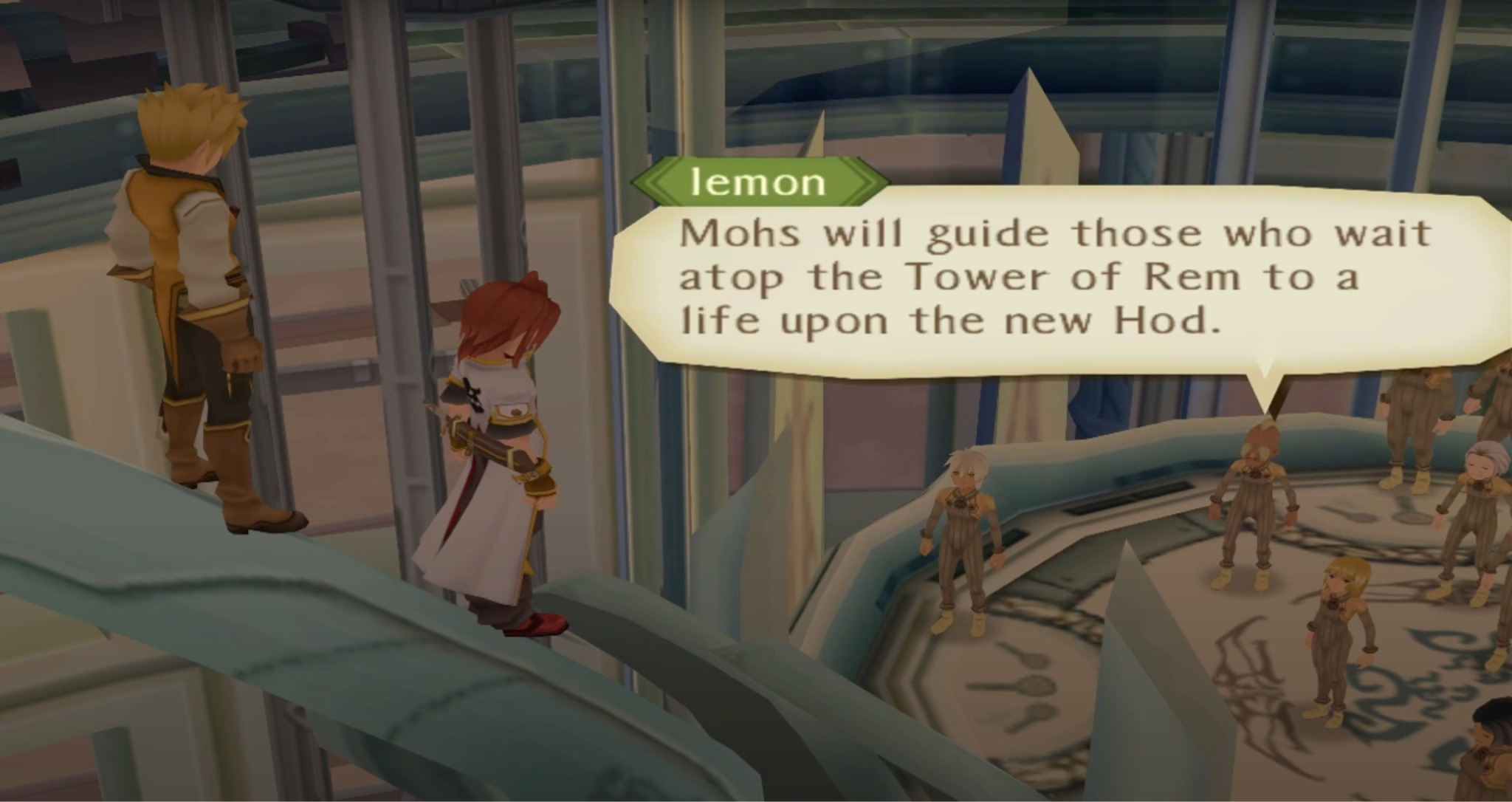
The self-aware Replicas attempt a mass exodus to “the new Hod,” Eldrant, lured by the false promise of Mohs and the New Order of Lorelei.
Finally, the esoteric meaning of the game’s core conflict emerges from the intersection of (1) Van’s seizure of Hod, (2) Mohs’ corrupt relationship with the Score, and (3) the exile of the Replicas, seeking meaning in a world that affords them none. Free will, as (mis)construed through the myopic lens of our own ego, tempts us to reject our “destined” roles in pursuit of self-determinism (Van’s seizure of Hod), yet the only way to realize this spiritually impoverished sense of “self-determinism” is to exile ourselves from the very world that gives us reasons for our existence (the exile of the Replicas). In exile, we seek a “new Hod,” a kind of prophecy and home in which to ground the value of our self-determined actions, as Mohs promises the Replicas will have in Eldrant. Yet this is a false promise, predicated on the possibility of community within an interpretive paradigm built purely upon the ego, which forbids any real connections between individuals (Mohs’ corrupt relationship with the Score). We arrive at the type of paradox that is characteristic of Kabbalistic thought: the flight from community catalyzed by free will—the shattering of spiritual unity—is also a flight back to community, yearning for Hod with a depth of feeling that would not be possible without free will. The challenge, then, is not to resolve this paradox, but rather to understand the spiritual insight contained within it and thereby unite the created world with its infinite, divine origins through rectification. The journey of the player and Luke through Auldrant, in dialogue with Van, is exactly what this rectification consists in.
How Tales of the Abyss Turns Your Playthrough into an Act of Rectification in Lurianic Kabbalah
By reading the journey of the Light of the Sacred Flame as the Path of the Flaming Sword, we can extend the role of Kabbalah in Tales of the Abyss from an exegetical basis to a mystic activity. When we play the game through this perspective, we don’t just empower the people of Auldrant to rectify their world: we also join that world and rectify our own nature as players, humans, and creative spirits.
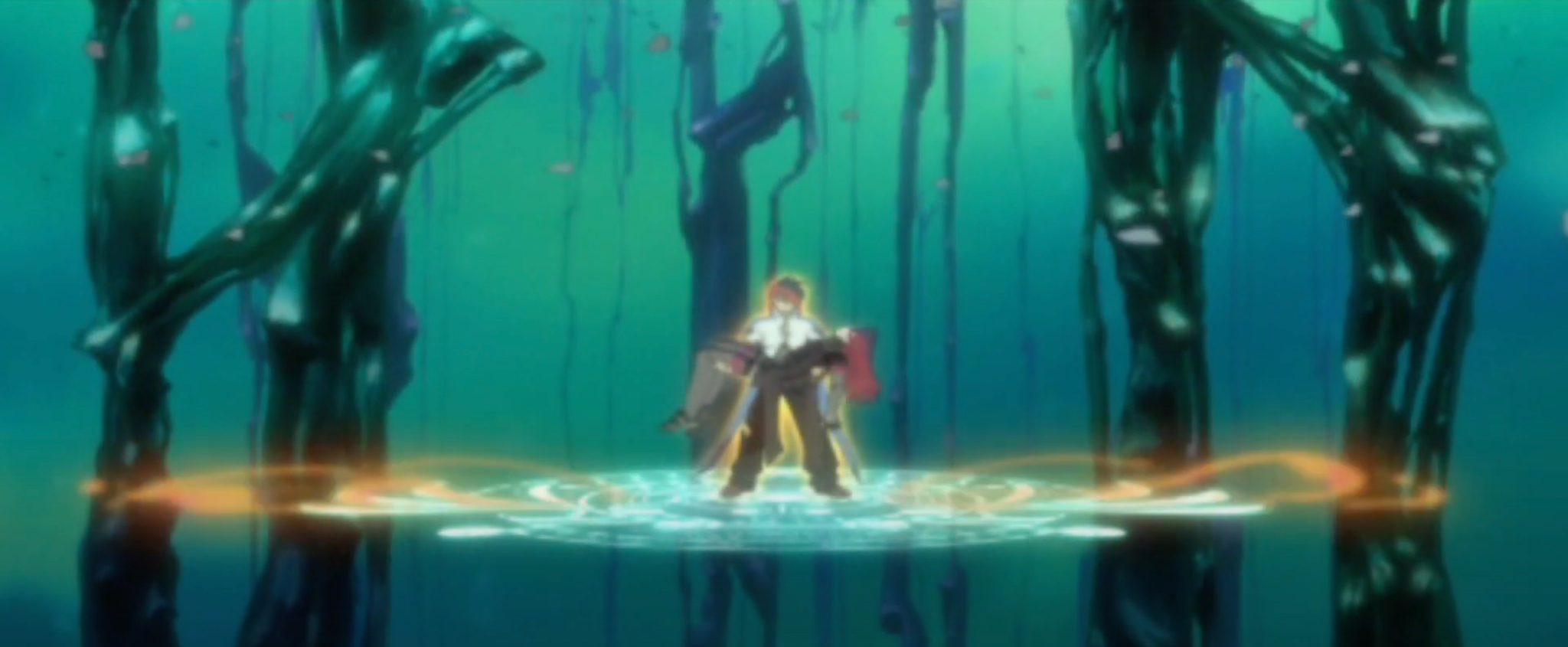
Luke and Asch, reunited, free Lorelei to pass on to the Fon Belt surrounding Auldrant.
Luke, the player, and the party enter a shattered world as an echo. Each of the protagonists finds an antagonist who embodies their own immoral, exiled “husk,” the corresponding Qliphoth to the respective Sefirot:
- In Asch, Luke finds a version of himself who bitterly withdrew his identity from the world after being reduced to a pawn in the Score and Van’s rebellion.
- In Arietta, Anise sees the broken passion of a Fon Master Guardian who ferally and blindly prioritized her vision of Ion over any other relationship or organization in her life.
- In Van, Guy feels the seething indignation that almost led him, like Van, to turn against the world in pursuit of vengeance for the lost homeland they shared.
- In Legretta, Tear recognizes that part of herself who hardened and turned cold to the world from a complicated relationship with her brother (both in terms of Legretta’s attachment to her own brother, Marcel, and in terms of Legretta’s own love for Van).
- In Largo, Natalia witnesses a father who was used, like her, in the service of replacing someone else (the stillborn princess), and renounced his nation, ruthlessly acting in service only of his own ideals.
- In Dist, Jade confronts an outcome he only narrowly avoided in his own case: sacrificing his existence in service of his scientific ambitions and childhood attachments, seeking to reanimate the teacher who molded his mind and character.
- In Sync, Ion beholds a would-be figurehead designed to replace the same leader Ion replaced, who gave into pure chaos and nihilism at the absurdity of literally being discarded into a volcano for not being a good enough “Ion facsimile.”
There’s an esoteric eighth pair we need in order to complete this list: the player herself, I think, echoes Lorelei in a way analogous to these other pairings, unifying the meaning of the player and avatar’s journeys with the overall spiritual arc of Tales of the Abyss. As the party members see their own exiled, shattered personae reflected in the God-Generals calling out for redemption, the player sees her own authority within the evolution of a game’s events exiled, shattered, and literally calling out for redemption in the collective consciousness of the Seventh Fonon, the Score’s sentience.

Lorelei, the mythologically named rock on the Rhine River in Germany. (Source.)
Lorelei is like the Shekhinah, the female aspect of the divine exiled in the created world following the Shevirat: an emanation of the divine, the presence of the divine within humanity’s physical, lower existence. It is the impression of creation’s overall trajectory within creation itself, made legible through the exegesis of Yulia, much as Luria’s exegesis clarified the relationship between the shattered spiritual realm and the sparks of divinity within creation itself—a framework for humanity to see its own divinity as the personal microcosm that harmonizes with the macrocosm of universal healing. Shekhinah is a divine emanation and impression that must be reintegrated within the whole of the universe, and which, if misapprehended from a position of egoism rather than holistic spiritual study, can be conceptually corrupted by practitioners like Van into a challenge to and juxtaposition against one’s personal agency, rather than the blueprint to how and why that agency can be used as a force for divine goodness. The name ‘Lorelei’ itself reinforces this interpretation: it originates from a German myth of a maiden who drowned herself in the Rhine River over an unfaithful partner, becoming a siren luring fishermen to death. The maiden’s name was also given to a large rock in that same river, famous for producing an echo throughout the river narrows.
I read the game as cautioning, as many mystic traditions would, that an intellectual knowledge of the cosmic order of the world is insufficient: the world’s cosmic order itself requires active participation in that order, making possible the experiential rectification of the physical and spiritual world through the animating force of the Kav. The Lorelei of German myth is a beneficent maiden, like the exiled feminine Shekhinah; it’s only in the context of unfaithful partners and wayward sailors that the intrinsically good maiden becomes misunderstood, an excuse for their personal downfall. As with Luke’s party relative to the God-Generals, we must acknowledge ourselves as the echo of Lorelei and resonate with the Score, rather than engaging with it from the alienated stance of coldly rational contemplation. Without this practical and suprarational discipline, the knowledge of that cosmic order only corrupts and misleads, as we saw in Mohs’ downfall—and as we see even in Tear’s home, Yulia City.[6]
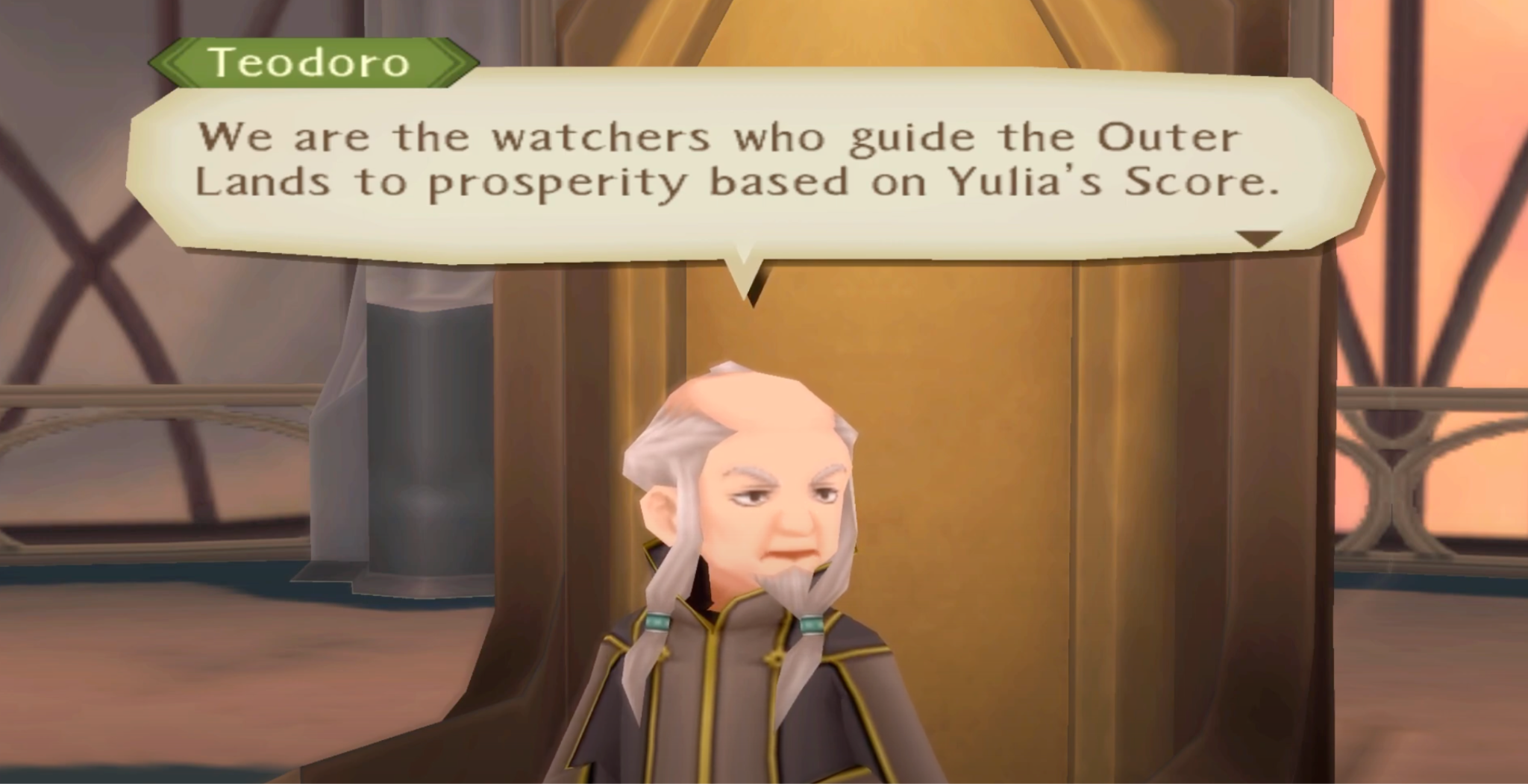
Teodoro explains the function of Yulia City to Luke and Tear.
At the outset of Tales of the Abyss, The Watchers’ Home, Yulia City, is the sole community in the Qliphoth, guiding humanity’s evolution in accordance with the Score from the shadows. Like Mohs, observing the letter of the Score is initially their one guiding principle, with Teodoro shrugging off Akzeriuth’s destruction as according with the Score, and rejecting the possibility of St. Binah falling due to this not being written in the Score. Yulia City is an esoteric clue to the inadequacy of the literal content of the Score in a Kabbalistic context, without spiritually attuned guidance: buried beneath the Outer Lands and occupied by “Watchers,” it recalls the Book of Enoch, which recounts the fate of a different group of Watchers: fallen angels who bred with humans, exposed humans to too much knowledge too quickly, and were punished for this by God ordering the other angels to bind and bury the Watchers beneath the earth. In the case of Azazel, for instance, who was largely responsible for teaching people more than they were meant to know, God ordered Raphael:
Bind Azâzêl hand and foot, and cast him into the darkness: and make an opening in the desert, which is in Dûdâêl, and cast him therein. And place upon him rough and jagged rocks, and cover him with darkness, and let him abide there for ever, and cover his face that he may not see light. And on the day of the great judgement he shall be cast into the fire. And heal the earth which the angels have corrupted, and proclaim the healing of the earth, that they may heal the plague, and that all the children of men may not perish through all the secret things that the Watchers have disclosed and have taught their sons. And the whole earth has been corrupted through the works that were taught by Azâzêl: to him ascribe all sin. (Enoch 10:4-8.)
Auldrant’s Watchers—”covered with darkness” in the Qliphoth, surrounded by miasma—embody this same kind of story. The advent of the Seventh Fonons that made possible the reading of the Score coincided with the development of Fontech, made possible by the Planet Storm—and leading to widespread war over how humanity ought to interact with the Score at all. Kabbalah reinforces that only those who are properly initiated, with the proper background and appropriate spiritual instruction from a teacher, can understand the esoteric lessons contained within the tradition; without the proper standing from which to practice, esoteric texts risk only leading the reader down confused, heretical roads. Just so, and ironically, the city named after Yulia refuses to contribute to the development of humankind at all, instead passively observing from a cold and rational distance to ensure that events are consistent with the letter of the Score; the City itself embodies innovations that outstripped the human capacity for understanding, its buildings developed through advanced Fontech that modern humans can neither understand nor replicate. Only the unambiguous deviation of world events from the Score (the fall of St. Binah) manages to convince Teodoro and the rest of the City to treat humanity as an end-in-itself rather than as a means to satisfy the predictions of the Score, leading them to focus less on the upholding of the Score as an exercise in purely predictive astrology (astrology was one of the fields of knowledge passed on from the Watchers to humanity in Enoch 8:3) and more on empowering humanity in a way consistent with the spirit of connectivity implied by the Score (e.g., opening the City to refugees from the fallen St. Binah to effectively resolve a humanitarian crisis).
The Score seen in this light—this exiled, cosmic emanation of the planet and humanity’s place within it—is like Lorelei’s namesake: an echoing siren (or stone, or collection of seven (Fon)stones) spelling doom for those who misapprehend this emanation of the divine, with which humanity must resonate, with the divine per se, a dictum that determines the final value and course of all human action. In both Tales of the Abyss and Lurianic Kabbalah, the initial created state of the universe is the furthest possible thing from harmonious and perfected: the political bodies, individual determinism, and planetary balance of Auldrant are all in flux precisely because they are fragmented, determined to assert their individual identity in the face of community; the Sefirot that would harmonize with each other as Partzufim once their vessels mature are shattered, demanding rectification. To treat Yulia and Luria’s transmissions as purely descriptive rather than primarily instructive is to nullify the value of your personal agency in a theosophical framework that demands that agency in order to function. This practical mistake unites the desperate insanity of Mohs, the withdrawn agency of the would-be-JRPG-party God-Generals, the subterfuge of Van, and the state of Auldrant as we discover it at the start of the game: as much as these characters and societies might seem diverse in their treatment of the Score, they all treat it as a static, agent-independent account of who they are and how their personal and cultural narratives will unfold. The key to correcting this mistake just is the player’s activity with Luke and his friends, rectifying Auldrant and reintegrating physical and spiritual realms in the same way which Luria prescribes for rectifying our real physical and spiritual worlds.

Diagram of the Path of the Sacred Flame, the order in which the Sefirot (and, by extension, the spiritual and physical universe) were created. (Source.)
Kabbalah refers to the sequence in which the Sefirot were created as the “path of the flaming sword,” beginning with Keter and descending through Malkuth. Luke—“the light of the sacred flame,” in Ancient Ispanian—takes a similarly spiritual path in the plot of Tales of the Abyss, harmonizing the universe by harmonizing himself. By completing this plot with the player, he achieves the correspondent healing that Lurianic Kabbalah finds in rectification: he heals his world “from the ground up,” beginning with the individuated and corporeal (the particular characters within the “created world” of Auldrant), while the player correspondingly heals it “from the top down,” beginning with the unknowable and universal (extending her agency into the created world of Auldrant from outside of it, like the Ein Sof moves creation while remaining ontologically prior to, and not directly accessible to those within, it). By the time the game is completed, these two antithetical paths enclothe themselves within each other, harmonizing as the Sefirot do when the Partzufim are made manifest.
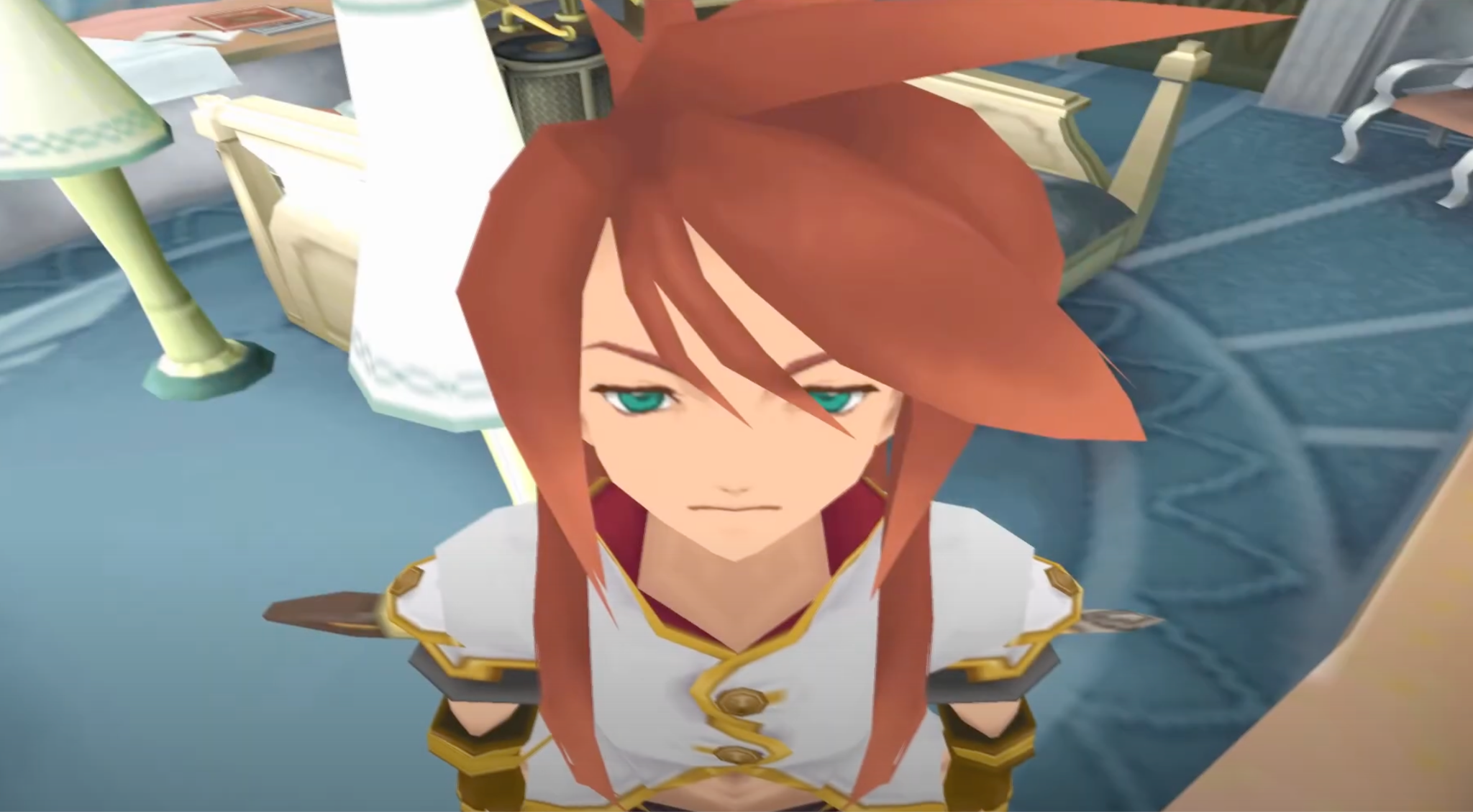
Luke fon Fabre looks out his room’s window at the outset of Tales of the Abyss.
Within the first two minutes of the game, Tales of the Abyss goes out of its way to create a gulf between its player and avatar, catalyzing their differences rather than encouraging identification between the two. The story opens with Yulia’s recitation of the part of the Score detailing the birth of the original Luke and Van’s destruction of Hod; after this foregrounding of prophecy and conflicts on an international scale, the game cuts to the above image of Luke looking out his window—looking out at the game’s fourth wall, eyes dull, expression morose. A story’s opening sentence, image, or moment often captures the upcoming plot and themes in subtle detail, and Tales of the Abyss expresses the core of the player’s initial relationship with its protagonist in this one shot: Luke is self-involved yet disengaged, staring at the Fon Belt and the player with no interest or understanding in the broader world they represent. His protracted silence and solitude after the drama and promise of the game’s prophetic opening animation already tell us symbolically what we only later learn is literally true: he is vacant, not yet a real person and no more animated than any other avatar disconnected from its player, with no history or identity through which to relate to those beyond his own blank stare.
This first shot introduces the player to a story where her relationship with her avatar is just as dynamic and challenging as the overall plot, if not more so. We set off on a journey with an avatar who feels as though everything he’s asked to do for someone else is an imposition, only feeling resentful and insecure as a party of better-adjusted companions forms around him. For this reason, the first act of Tales of the Abyss demands a leap of faith: for the player to continue animating its world and advancing its story, she must trust that her unlikable, unsympathetic avatar will ultimately redeem himself. I find myself wondering how many players put the game down prior to the events of Akzeriuth for exactly this reason; those who remain committed to it, however, are thereby personifying what we might expect of the Kav continuing to animate the created world during the era of Shevirat. For the divine to impart humankind with free will requires the divine to trust that humans will resolve to rectify the universe and their own spiritual identity when they have the option not to do so. This leap of faith also unites the player’s activity in Tales of the Abyss with the trust demanded of someone who walks a mystical path in her own real life: the practitioner must believe that the eventual perspectives and insights to which she will have access justify the difficult, sometimes arbitrary-seeming tasks required of the path.[7]
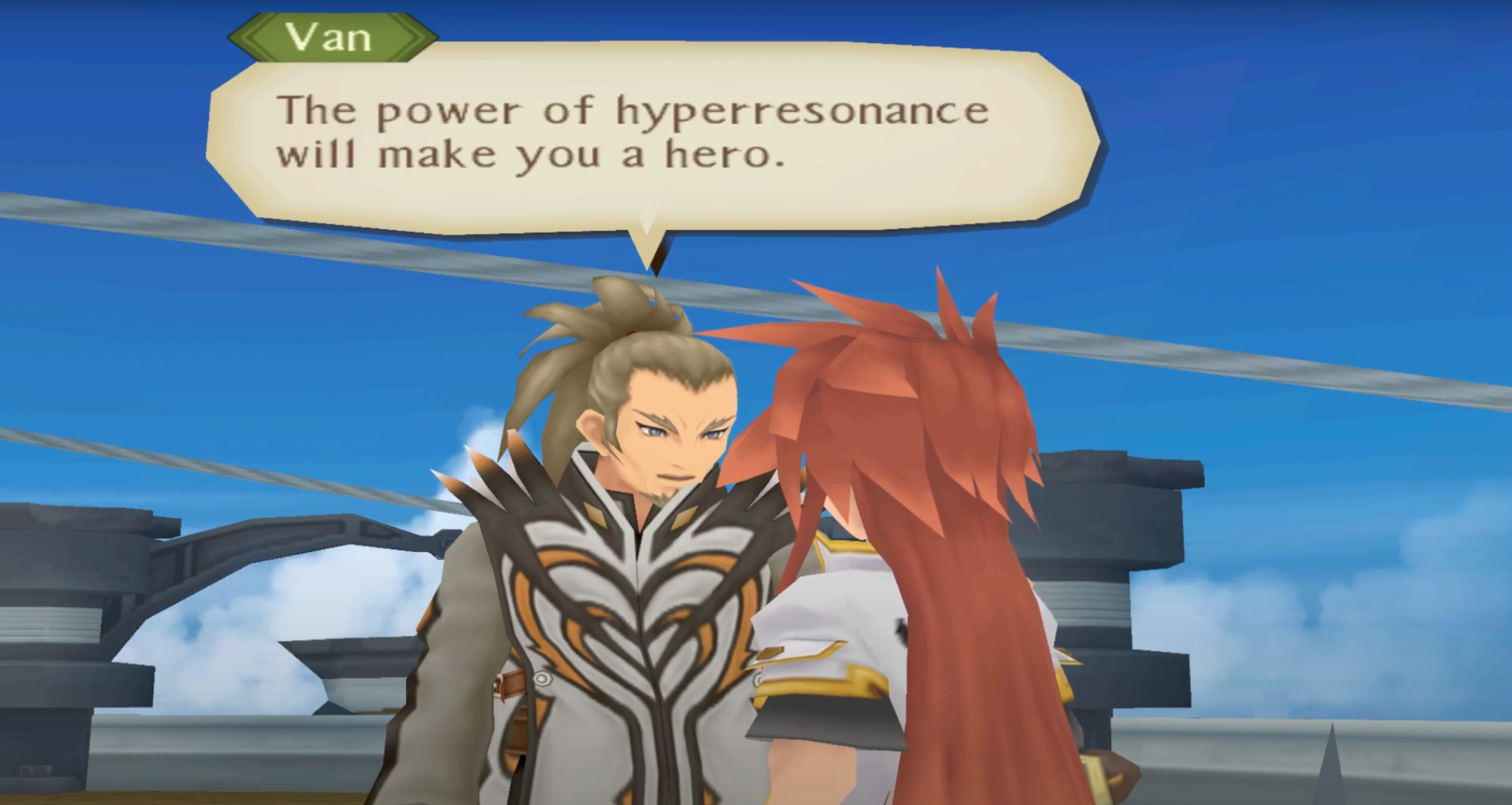
Van deceives Luke into destroying Akzeriuth by promising him that he can become a hero through his hyperresonance, freeing himself from a life of imprisonment by Kimlasca.
Luke must personally participate in Shevirat before he can rectify himself, and he must rectify himself before he can rectify the world. His personal downfall comes from Van deceiving Luke into doing the same thing that Van was forced to do as a child: causing a hyperresonance and collapsing a Sephiroth Tree, sending Akzeriuth plummeting into the Qliphoth and doing violence to the delicate balance between the Qliphoth, miasma, and Outer Lands. It’s not obvious to me what “cycle” Lorelei has in mind when, speaking through Tear, he enjoins Luke to “set [Lorelei] free from the prison of this eternal cycle,” but I think that this is one likely candidate: those who already suffer from a feeling of impotence in determining their destiny (like Van) rail against this sense of powerlessness by manipulating others into feeling similarly impotent (as Van does with Luke); while it might seem as though these manipulations free people to act differently than their destiny dictates them to act, it really only exchanges one set of shackles for another: the Order of Lorelei becomes the New Order of Lorelei; Van’s role in the Score becomes Van’s vendetta against the Score; Luke’s prison in the fon Fabres’ manor becomes his imprisonment within Van’s cult of personality. This cycle illustrates the poison of free will when that will is used solely to rebel against the world: these activities one undertakes to liberate oneself only push one further into servitude, forming not only a cycle but also a downward spiral of perpetual exile, further distancing people from cosmic harmony with Fonons and the Sephiroth, raising the stakes and urgency of an ultimate rectification.
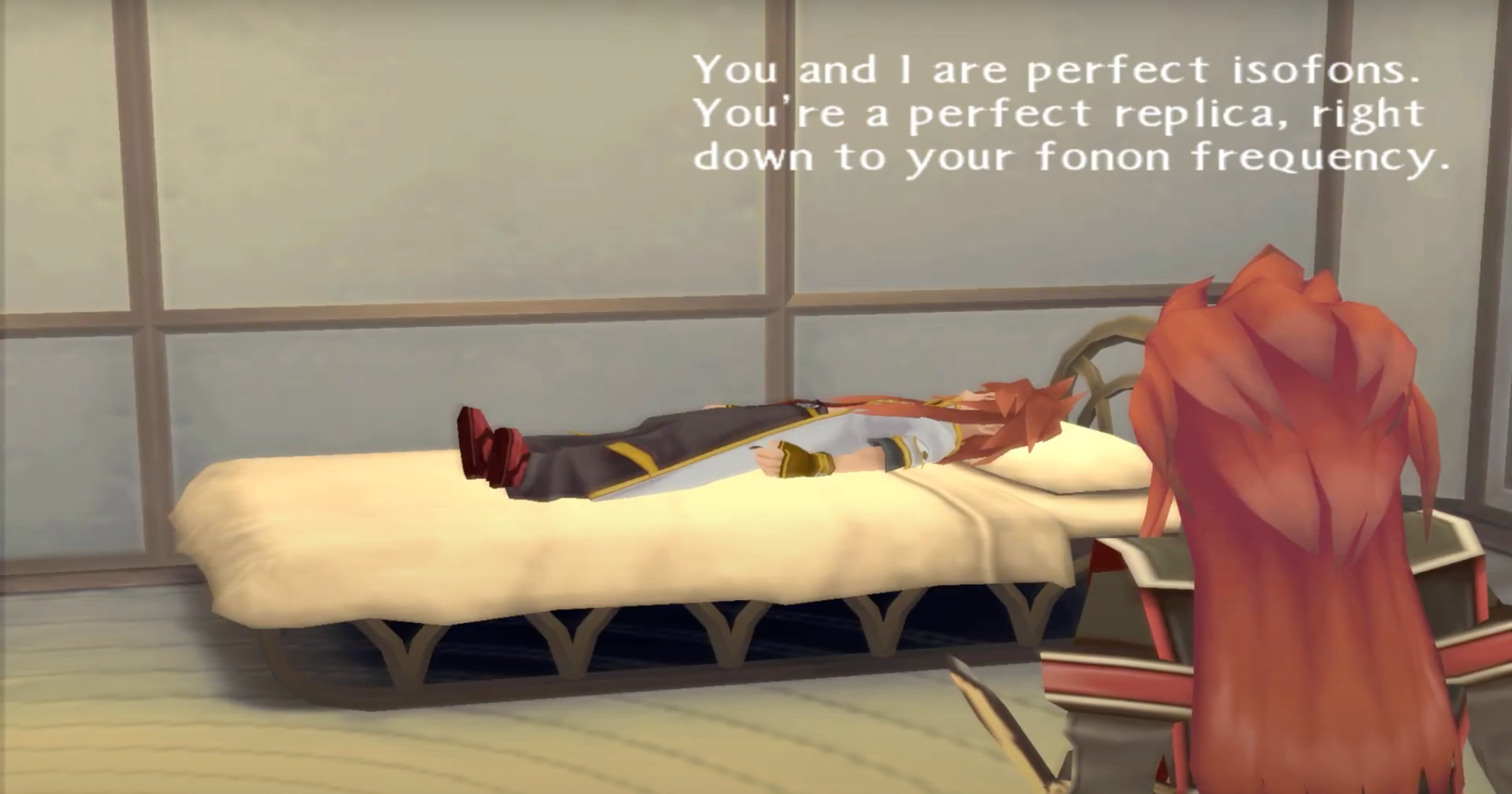
Asch explains to Luke their relationship after the two duel and Luke falls unconscious.
I think that Luke is able to pull himself out of this cycle and resolve to walk the path of rectification because of his special bonds with Asch, Lorelei, and the player: each gives him a distinct window into himself and his place in the world, which jointly empower him to exit the cycle and rectify the world at large. Luke, Asch’s Replica, mirrors his Fonon frequency, and is therefore able to literally share his perspective on the world, witnessing the sum of Asch’s previous life as a fon Fabre and his new life as an autonomous, resigned God-General all at once. They also share their Fonon frequency with Lorelei, the sentience of the Seventh Fonon, allowing Lorelei to express its desires directly to them and even control their bodies on occasion, as they can also do with each other. This metaphysical ability of Lorelei to exert direct control over Luke and Asch, I think, also motivates introducing the player, as a character unto herself, into the esoteric meaning of the story: just as Lorelei is able to exert control over Luke from within the world, so the player is able to exert control over Luke from without the world, peering in on him and his journey from behind her controller. Combine this with our Kabbalistic interpretive lens, and we can read the player and Lorelei as two poles of divine emanation: Lorelei is the imminent divine, the exiled Shekhinah seeking rectification in the created world, and the player is the Kav, that ray of divine light that animates the created world from the Ein Sof, that which is beyond the world and comprehension (much as the player is beyond Auldrant and cannot be comprehended by its people).
Luke’s connection to Lorelei and the Score identifies him as a destined hero, but this isn’t enough for him to answer the spiritual call: without expanding one’s consciousness beyond the confines of one’s individuated identity, a destined role in the Score can be misconstrued as a purely egotistical proposition, as when Luke falls under the spell of Van’s suggestion that he can free himself by becoming widely known as a hero for his actions in Akzeriuth. To expand beyond this realm of understanding requires expanding your self-concept beyond the ego—something made uniquely possible for Luke through the existence of Asch, forcing Luke to confront the artificial nature not only of Luke’s identity but also of his presupposed destiny. According to mystic tradition, however, intellectually understanding this artifice of ego and the bond between the self and other is insufficient: this unity of perspective must be experienced suprarationally, as sought through practices like meditation, in order to erase the boundaries between the self and the rest of the community (and, ultimately, the rest of the universe). This is where the activity of the player animates Luke and sends him off on a spiritual journey. That perspective and agency from beyond Auldrant has the standing to unite multiple perspectives under a single directive and narrative, as exemplified in the spiritual turning point of the story: Luke falling unconscious, broken and resigned, after the destruction of Akzeriuth, and the player taking control of Asch, as Luke looks on and experiences Asch’s actions, motivations, and drive as though they were his own. Ironically—and in exactly the way that mysticism suggests—this pure fusion of Luke and Asch’s perspective, dissolving the difference between them, is what makes Luke resolve to become his own person: not positioning himself in favor of or against some ordained set of future events, but rather interrogating and acting upon what is best for the world as a whole, appealing only to his personal responsibility to explain his actions.
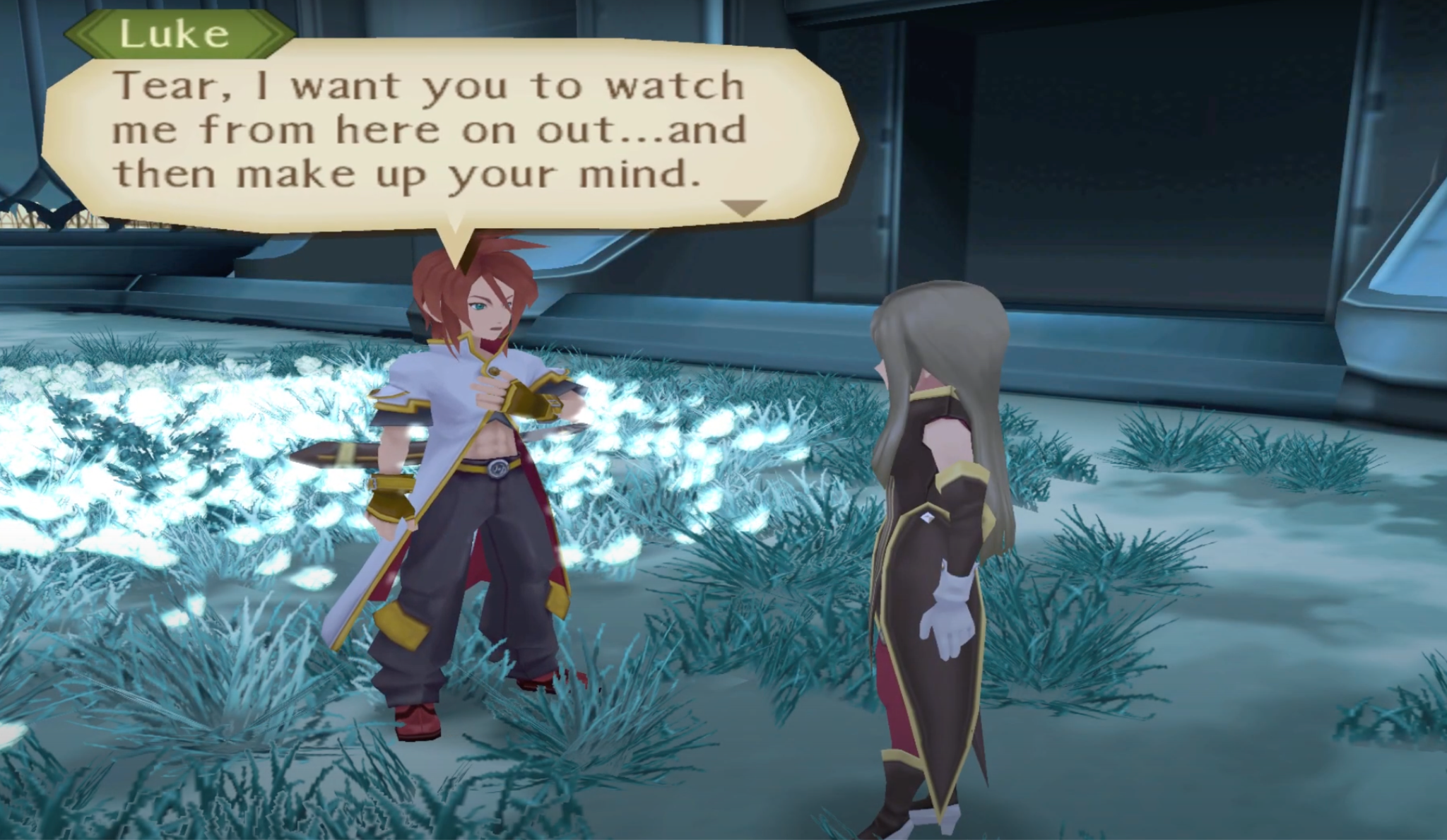
Luke asks Tear to watch him, after cutting his hair and resolving to take accountability for his actions.
Luke holds himself accountable by asking Tear to “watch [him],” taking her on as a kind of guardian overseeing his spiritual development: she observes him, chides him, mentors him in controlling his hyperresonance, helps to cultivate his views on the weight of a human life and self-sacrifice, and ultimately comes to love him. Here, we find another case of the dualities whose balancing is necessary to spiritually develop in Kabbalistic practice, for Luke ultimately develops from a shattered Replica into a fully-fledged human being through the harmonic efforts of two teachers, antithetical yet literally and figuratively siblings to each other: Master Van creates him, manipulates him, and compels him to determine his own purpose in life, whereas Tear bears witness to him, nurtures him, and loves him for who he is irrespective of any particular purpose. Van and Tear stand on opposite poles of active and passive guidance for Luke—one of the highest-order distinctions between divine energy in Kabbalah, resonating in this case with the Kabbalistic distinction between “masculine” and “feminine” energies, respectively.

Van acknowledges Luke as “a true human being” before their final confrontation, after Luke has absorbed the spirit of Asch.
This interpretation helps me to demystify my experience with the final battle against Van. I feel something anticlimactic in a final boss fight with a teacher who is striving to recreate the world, particularly when weighed against more typical JRPG climaxes of fighting a god, or evil incarnate, or some other purely destructive energy made manifest. Rare is the JRPG where the hero still calls the villain “Master” despite being deceived and discarded by him; rare is the hero who says “thank you” to the villain after killing him. But on this interpretation of the game as Luke’s spiritual development, this climax becomes less about saving the literal world by defeating Van and more about saving the spiritual world by, as Van says, completing Luke’s journey to become “a true human being.” The completion of that journey is a carefully harmonized symphony between Luke and his two teachers: he must accept the active principle of his own agency by rejecting Van’s authority, demonstrating, as he tells Van, that the meaning of life is in merely living rather than in serving some intrinsic or extrinsic purpose; he must accept the passive principle by accepting the dissipation of his own Fonons into the cosmic, for the sake of freeing Lorelei—the cosmic projection of that same Fonon frequency—and rebalancing the universe at large, the kind of self-sacrifice Tear endorsed for herself when she opened the Passage Rings to the Sephiroth and took miasma into her body—and the kind she must allow from Luke at the same moment she declares her love for him, an act of passive and pure acceptance.
This is the same duality we see in the ultimate weapon of the covenant with Lorelei, the “Key” forged from a Jewel that disperses Seventh Fonons and a Sword that gathers Seventh Fonons. It’s the duality that was prophetically promised in the childhood of the two siblings-who-would-be-teachers from Hod, that land named after the Sefira of cleaving to prophecy: Van taught Tear the Seventh Fonic Hymn as a child, singing it to her as a lullaby, which becomes the key to her singing the Grand Fonic Hymn and releasing Lorelei from him in the final battle. When Luke finally fells Van, Tear acknowledges to Van that even back then, in their childhood, “[y]ou knew what the fonic hymn meant. You were telling me everything…right from the start.” On its face, this line is mysterious; esoterically, it captures Van and Tear’s dual roles in awakening Luke and repairing the cosmic order: for Van to have known the meaning of the hymn that would free Lorelei and undo him, I think, is for him to have known that humanity could only move beyond its fractured state of servitude to the Score by existing as a part of Lorelei, a part of the cosmic order, without governing their actions according to or in opposition to the Score—and that spiritual growth could only happen by confronting and overcoming the final form of Van, that antagonist who, with Lorelei bound inside his body, perfectly embodies the tragic conclusion of the man who surrenders his own agency in pursuit of freedom. Antagonist though he is, Van ultimately reveals himself as unique and central to the rectification of Auldrant, Score and all.

Luke and Tear confront Van, with Lorelei embedded within him.
The consummation of this rectificatory climax is Tear’s declaration of her love for Luke, uttered with them facing away from each other in the final moments before Luke frees Lorelei, expecting to disappear forever. This moment, too, I read as rife with esoteric meaning: without introducing spoilers from other games, modern Tales fans know that the series understands how to tell a love story, and this doesn’t feel like that kind of climax to me. Tear and Luke are facing opposite directions; Tear’s words “I love you” are voiced, but not reified through text in her speech bubble (see the below gif); and while there are undertones of attraction between them throughout the story, their relationship resists a purely romantic characterization, with one of their central side stories—Tear teaching Luke to control his power of hyperresonance—culminating in her earning the title of “Big Sister,” acknowledging the intimate familial care with which she’s taught and protected the immature Luke. When “Luke” reappears in the epilogue to the game, his presentation suggests that he’s no longer the character Tear knew and loved, but rather a synthesis of Luke and Asch, song and echo united. Kabbalah unifies this for me in a way that the model of a simple love story cannot: Lurianic Kabbalah, in particular, identifies the act of rectifying the universe with the union of the feminine aspect of the divine—the Shekhinah, the feminine and passive emanation of the divine within the created physical universe—and the Kav—the masculine, active emanation of the divine that coordinates the evolution of all created existence across time. On this view, the relationship between Luke and Tear in Tales of the Abyss isn’t that of a standard romance: rather, it’s the story of a spiritual marriage between two antithetical and alienated aspects of the Ein Sof, the divine totality—a divine love that is ontologically prior to personal love between humans in the created world, romantic or otherwise.
The game begins with Lorelei, the metaphysical basis of the world’s development, recognizing the bond not yet apparent to Luke and Tear, declaring to them, “Resound…! The will of Lorelei shall reach you… and open the way!” This resonance instigates a journey that doesn’t just feature Luke’s fall from grace and destruction of Akzeriuth, but also the collaboration between Luke and Tear to repair the Sephiroth—and thereby, symbolically, to repair the universe: the linking of the Sephiroth—according to which they cease being independent and become mutually interdependent, as required in the Lurianic schema of rectification through the formation of the Partzufim—is uniquely possible through the synthesis of what Kabbalah would view as Tear’s feminine energy and Luke’s masculine energy. Tear opens and receives Seventh Fonons from the Passage Rings by dint of her shared lineage with Yulia, the prophet who first articulated the imprinted residue of the divine in the form of the Score; Luke rewrites the Sephiroth’s relationships with each other through “brute force” guided by Jade in erasing and inscribing the proper words to command the measured lowering of the Outer Lands—and ultimately, his power of hyperresonance honed (with Tear’s help), erases the miasma itself with the support of Asch and the willing Replicas. The gameplay itself reinforces this dynamic, with Luke acting as a proactive fighter and the player’s most direct conduit to the world (the player’s main avatar), and Tear (despite being playable) primarily acting as a coordinating support character in combat, exemplified in the final battle of Tear reciting the Grand Fonic Hymn in the background as Luke kills Van with Radiant Howl in the foreground.
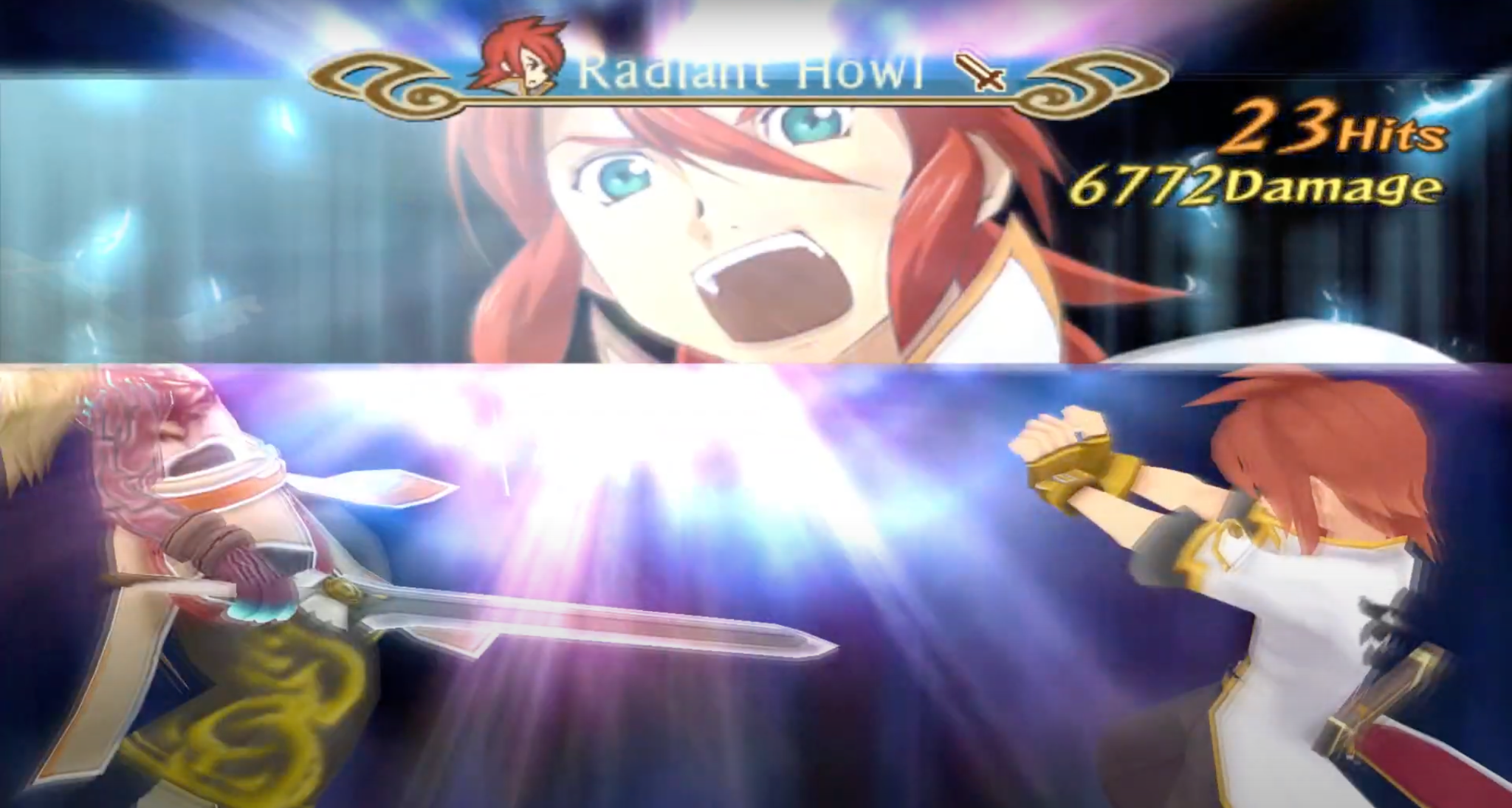
Luke delivers the finishing blow to Van as Tear recites the Grand Fonic Hymn in the background of the fight.
On our esoteric reading, this give-and-take development of Tear and Luke—the receipt of inexpressible energy from the planet, and the expression of suprarational wisdom through metaphysically meaningful words—is identical with the world of Auldrant coming to understand itself by transcending the Score, rather than according with or opposing the Score. The synthesis of this transcendence is Tear’s unwritten-yet-vocalized expression of love, facing away from Luke: it is a total, spiritual love that, in its mere utterance, transcends the words that represent it, as the spirit of cosmic divinity transcends the letter of Yulia’s prophecy.
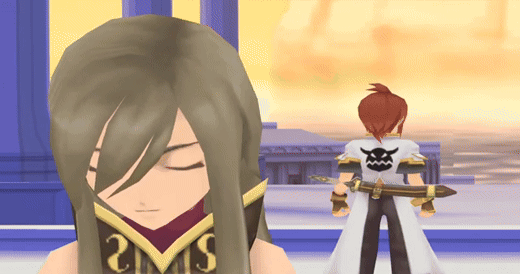
Tear tells Luke “I love you,” an utterance that transcends linguistic representation in speech bubbles.
Lurianic Kabbalah teaches us that as the physical world is rectified through the ethical practice of individuals (i.e. the observance of the 613 mitzvot), the spiritual world is thereby correspondingly rectified through a union of previously independent Sephiroth; just so, the union of Tear and Luke corresponds with the spiritual union between the player and Lorelei. As we play the game, we come to understand Luke’s independence from us at the same time that we animate his actions and spiritual journey. The game’s “synopsis” underscores this, doing away with the third-party objective narration of the plot’s events as we would expect from other JRPGs like Tales of Symphonia in favor of Luke’s personal diary, offering us details into his personal story and identity that we can neither determine ourselves nor discover from the main events of the game. It’s only in these records, for instance, that we learn Luke eventually comes to think of the “gesture” of cutting his hair as “insincere” and “weak” once Asch challenges his willingness to die in order to annihilate the miasma—a revelation that originates in Luke’s reflections on Asch, his other aspect, not in the player’s motivations for Luke or Asch’s actions (“Where the Original Belongs”). In these reflections, we witness the birth of a hero who is inextricably bound to the planet’s fated history—Fonically identical with Lorelei, bearer of the Score—yet who reflects on his motives and resolve to action irrespective of what those actions may or may not contribute to the planet’s destiny, effecting the kind of authentically free will which Vandesdelca seeks yet cannot seize.
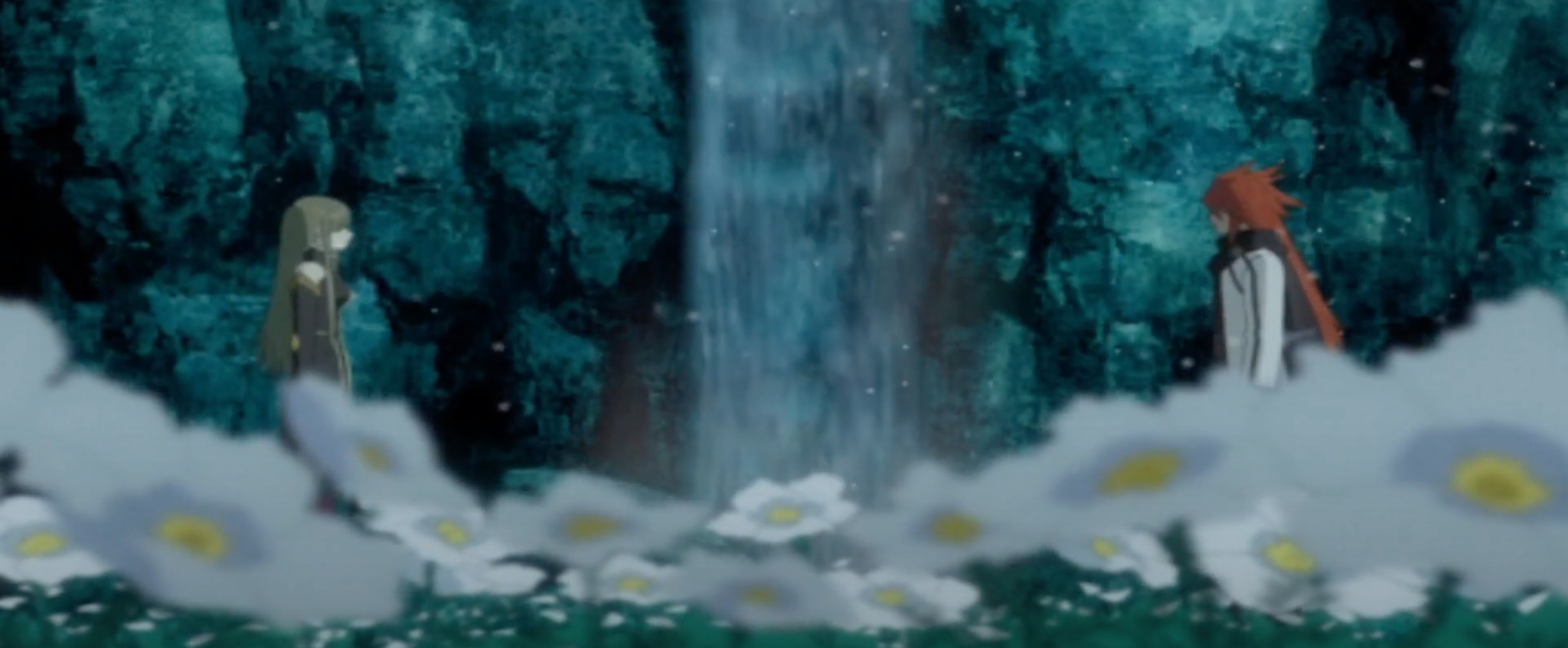
“This place has a nice view of Hod. And also… I promised someone.”
Luke is ultimately able to wield the Key of Lorelei because he comes to embody that same duality of the Key, the one which Van does not grasp: the embrace of one’s individual capacity to shape the universe autonomously (the dispersal of Seventh Fonons) and one’s submission to the broader cosmic tapestry in which one constitutes a single thread (the gathering of Seventh Fonons). The culmination of this personal development manifests in the game’s very last scene, when a new Luke—an apparent synthesis of Luke and Asch—appears in Tataroo Valley on the day of Luke’s coming-of-age ceremony, following Tear’s recitation of the Grand Fonic Hymn. In this new Luke, we see the character we players drove as our avatar throughout the game, the character through whose perspective we accessed the world—yet we also see the character in whose footsteps we were always following, whose existence was fated in the Score, the character whose story always seems to be just out of our reach until the moment of his final duel with Luke in Eldrant. The rectification of Luke and Asch, of avatar and (mostly) NPC foil to that avatar, corresponds with the rectification of the Score—that limited, exiled residue of the divine within the world, which can only see the fated destruction of the world which would come to pass in the absence of cosmic rectification—with the agency of the player—that active, divine agency without the world, inspiring spiritually attuned members of that world to rectify themselves and thereby overturn the “Score of extinction” written on the Seventh Fonstone by healing the universe in a way inconceivable to that exiled divinity within the corrupted, physical existence of Auldrant. This is the esoteric meaning of Lorelei’s final remark when he appears, released from Van and Auldrant, to Luke and Asch:
“So the world did not vanish. To think, the future I saw would be rewritten. You have done admirably.”
The admirable action which Luke and Asch committed was to discipline and cultivate themselves in accordance with the Kav, animated by the spirit and actions of the player; that motive force made possible the cosmic healing of Auldrant that would not have been possible without the spiritually grounded exercise of free will. Lorelei saw the vanishing of the world because of its limited divine perspective within the static world of Auldrant; the player’s agency is the missing piece required, not to overturn Lorelei, but rather to integrate its embodiment of the physical world’s destiny with the trajectory of the broader spiritual universe. That Luke is the nexus of this dialogue between plot and player is what marks him as the messianic figure of this world, his personal journey as the Path of the Sacred Flame; that the new, rectified version of Luke and Asch appears in response to the Grand Fonic Hymn, I think, esoterically expresses the complete synthesis of heaven and earth, creator and created, player and game world. Remember that the Grand Fonic Hymn is itself the symbol of the covenant between Yulia and Lorelei and, together with the Key of Lorelei, is said to be able to summon Lorelei: for Luke to appear in response to it in the place where his journey with Tear began and remark that “[t]his place has a nice view of Hod”—the Sefira of submission to the divine and prophecy, which Van so ardently resisted—illustrates to me that the isofons of Luke, Asch, Lorelei, and even the player have resonated and finally integrated with each other, like Luke absorbing the Fonons of the Jewel of Lorelei or the spirit of Asch. Once the universe has been rebalanced, to summon Lorelei just is to summon Luke: the distinction between them, like the distinction between the world of man and the world of the spirit, has been erased in favor of sublime unity. As Luria’s key to cosmic balance is the divine personae, the Partzufim, dynamically enclothing themselves within one another, so Tales of the Abyss ultimately shows us Luke and Asch within each other, no longer in conflict; so it ultimately shows us ourselves within Lorelei, and Lorelei within us.
Tales of the Abyss as a Meditative Act
I play through Tales of the Abyss as if I were an echo, and I complete the game as if I had finally caught that song of myself from which that echo had been born.
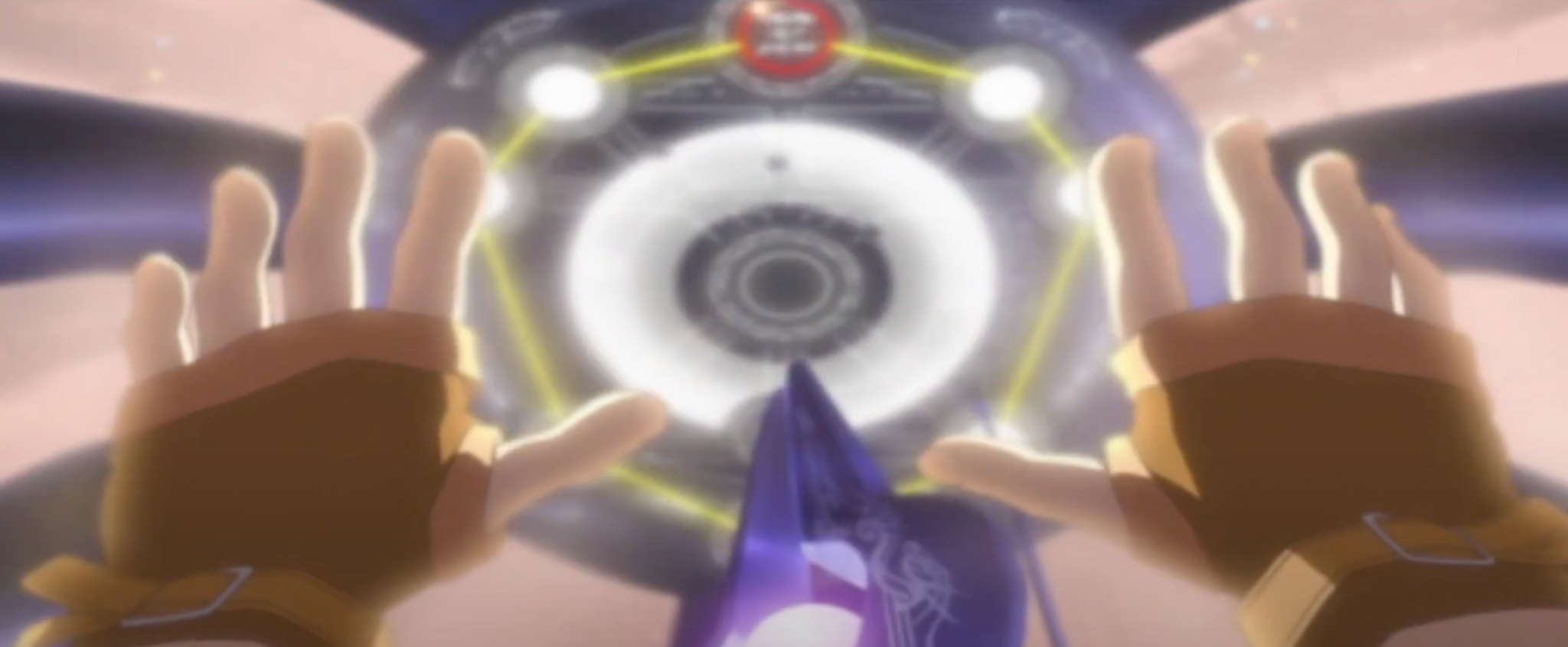
An illustration of Luke’s field of vision as he uses the Sephiroth to safely lower the remaining Outer Lands back into the Qliphoth.
Like many mystic traditions, Lurianic Kabbalah includes regimented guidance on how to use meditation as a practice for stepping beyond one’s rational conscious experience in pursuit of experiencing one’s place and agency within the divine topology of existence as a whole. As Kabbalah teaches the metaphysical potency of Hebrew names and Luria teaches the mutual enclothement of seemingly oppositional Sephiroth and Partzufim as the path to rectification, so Lurianic meditation (called Yichudim) counsels practitioners to focus on the names corresponding to the presence of the divine within different Sefirot—different levels of groundedness relative to the physical world, versus the higher spiritual worlds—and “merge” those names together in their mind, linguistically enclothing them within each other as their corresponding spiritual concepts are enclothed within each other. ADNY, for instance, the divine name associated with the lowest Sefira, Malkut, is merged with YHVH, the divine name associated with the middling Tiferet, which is then merged with AHYH, the divine name associated with the highest Sefira, Keter; this process is repeated as a kind of psychical ladder of ascension through the Sefirot of the four hierarchical spiritual worlds of Kabbalah, leading the mind of the meditator to sequentially link together all divine emanations from the physical world up to the Ein Sof, the unknowable origin.
I read the overall experience of playing Tales of the Abyss as this kind of meditative practice. As Lurianic Kabbalah offers practitioners the tool kit to ascend the ladder of spiritual understanding through a ladder of exegetical studies, so this game offers us a semantic framework through which to ascend from the “physical world” of Auldrant and its people’s story up to the “spiritual” world of us, the players who animate that story from a realm beyond it. In this context, the game’s name itself captures the Kabbalistic content of the player’s activity within it: we are working with Luke to bridge that abyss between the seven lower Sefirot of the created world, with which Luke and his world resonates, and the three higher Sefirot of the spiritual echelon above creation, to which the player and her world beyond belong. People in the created world are able to bridge this abyss and reach the upper three Sefirot through the fourth Sefira, the unconditioned and spiritual love of Hesed—the kind of love, as we’ve seen, that’s enacted both personally and cosmically through the relationship between Luke and Tear.
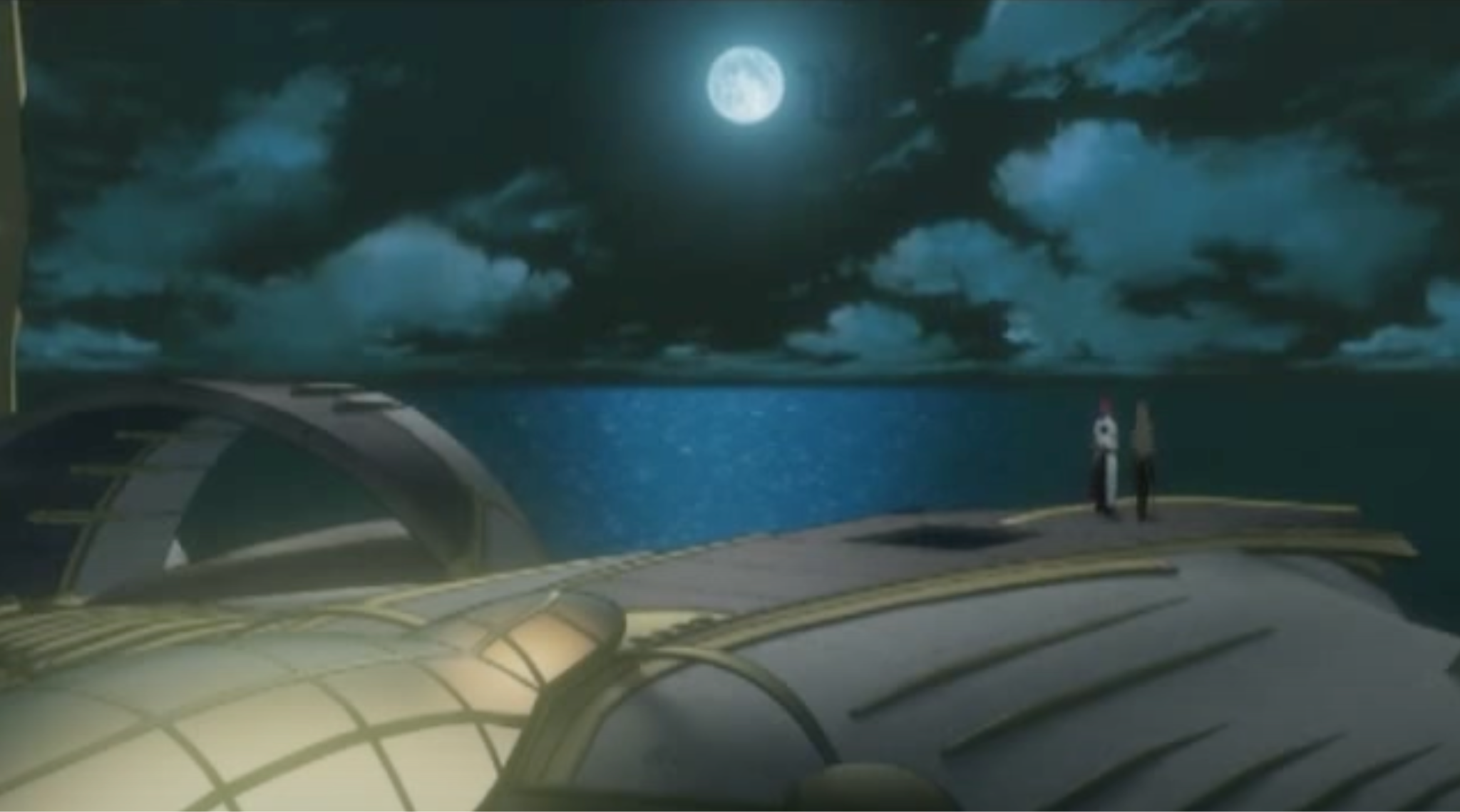
Luke and Tear face Auldrant, the moon, and spiritual rectification together on the night before they set off for their final confrontation with Van.
I’ve returned to Tales of the Abyss more than once over the years, not to reacquaint myself with a familiar and satisfying story, but rather to struggle with the mystery of the plot and its meaning afresh. More than the location names, exegetical similarities, or thematic parallels, what marks this game as esoteric and Kabbalistic for me is the way it moves my own spirit at the very same moments that it resists a clear-cut sense of resolution for its characters and their stories. Even after our work interpreting Luke’s union with Tear, his synthesis with Asch, and his act of freeing Lorelei by transcending Lorelei, the logical basis for these interpretations is elusive, making it seem as if we are working more closely with dream logic and free association than with a firm theoretical foundation. And yet, as Luke did when Asch died in Eldrant, I get “a feeling like something warm falling into me” when I play through and bring about the future of this world—when I see myself in Lorelei at the same time that I move beyond it.
I think that this is my version of what a young Ludwig Wittgenstein called “the mystical feeling”: “[t]he feeling of the world as a limited whole,” a totality which, paradoxically, simultaneously depends on yet subsumes our agency as individuals (Tractatus Logico-Philosophicus 6.45). By placing its player in a role parallel to that of the Ein Sof—that unknowable progenitor become the created world’s limits—the Kabbalistic video game presents an unusual model for Lurianic meditation: climbing the ladder of enclothed concepts leads us to ourselves, allowing us to reflect on the divine creative force of our own place in the world—this in contrast to a typical meditation that begins with our particulars as people within the physical world and abstracts away from them to the divinity beyond ourselves, in which we participate. As we help and witness Luke maturing through accepting both personal responsibility and submission to the cosmic order, so we can challenge and develop ourselves by reflecting on the content of our own actions and role as players while we learn more about Lorelei, that “other player.” In Lorelei, that engrained order of destined events, I feel the pull of my desire to control the events of a game’s world: to revel in my own agency and place within that world as I dictate how and why the plot will evolve as it does. Yet in myself, juxtaposed against Lorelei, I feel that contrary urge to discover the organic development of a world that lives and breathes beyond myself: to lose myself within a sublime universe as I peer into Luke’s diary and discover the will of an avatar who decides his course without my input. I think these urges are both deeply human, and both brought to the fore in the player-dependent storytelling of video games. In other games, one impulse might be foregrounded with the other muted; or, if we feel the tension between them, it is the tension of an unsolvable paradox, inspiring in us a discomfort of never satisfying both these faces of ourselves when playing a video-game story. It is the Kabbalistic rectification of Tales of the Abyss that invites me to enclothe each of these modes of my experience within the other: to imagine myself not as pulling in opposite directions, but, like our final image of Luke—like Luria’s images of the Partzufim—to feel complete exactly because of the coexistence of these two sentiments in my activity throughout the game.
Luke’s final words to Tear are that he “made a promise to someone,” a duty that must simultaneously refer to Asch’s promise to Natalia that they would put an end to war, and Luke’s promise to Tear that he would return from Eldrant. Tales of the Abyss esoterically teaches me that I am bound by an identically paradoxical promise: a duty to lead Luke and his friends to the destined conclusion of their story, yet a duty to empower them to make their own choices.
Bound, yet free.
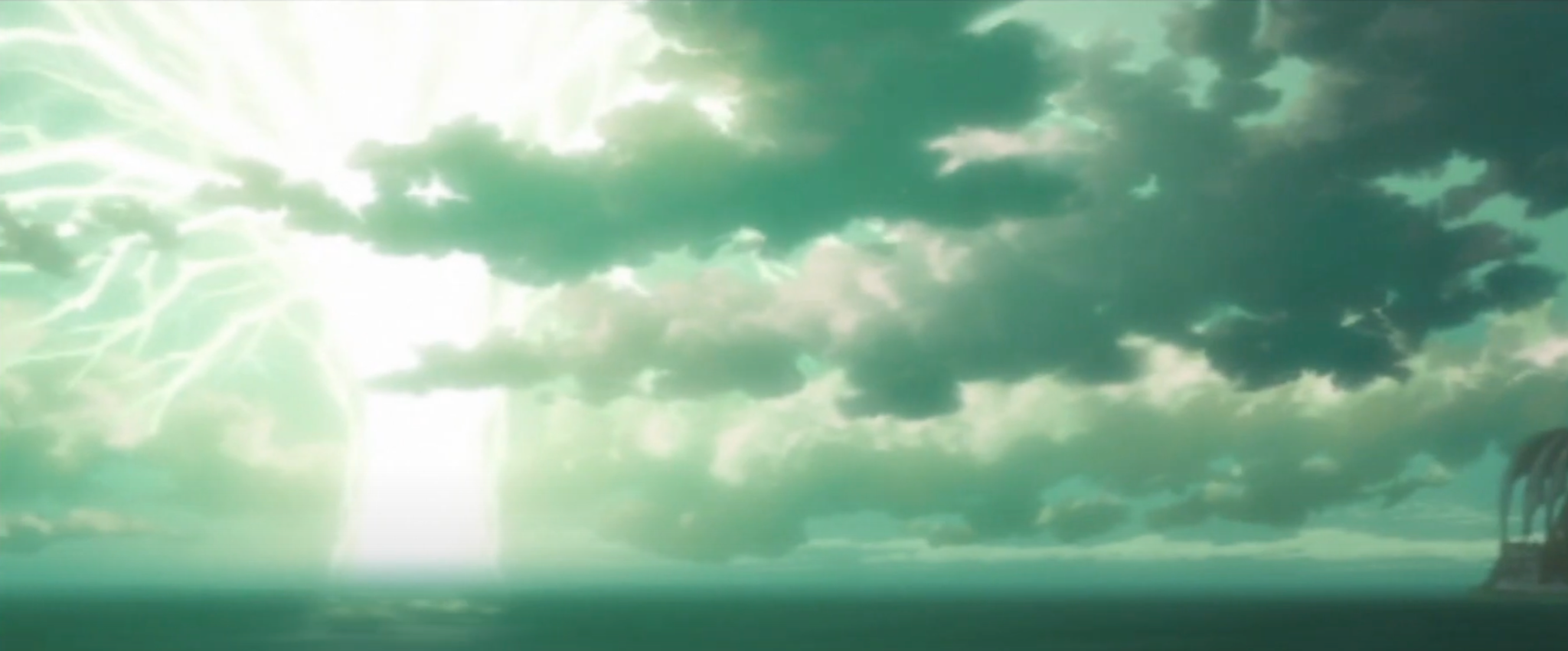
- I must express my most heartfelt thanks to my dear friend and colleague Makinde Ogunnaike for extensive commentary, discussion, and help with navigating sources pertaining to Kabbalah and mystic philosophy, all of which materially improved the quality and usefulness of this study. Thanks also to Dan Hughes for review and discussion of a previous draft of this study. ↑
- In this passage, I slightly massage Tales of the Abyss’ spelling of Daath, Grand Chokmah, and Malkuth, in order to better highlight the overlap between those names and the names of the relevant sefirot. ↑
- This is effected through the recitation of the Grand Fonic Hymn while wielding the Key of Lorelei, discussed further below. ↑
- Arietta is the one God-General who isn’t known to have a former name which she abandoned, but given that her parents and home were wiped out when she was still a child, it’s reasonable to suppose that she likely had a different original name and identity that was washed away with the Isle of Feres, rewritten by her attachments to Van, Ion, and the Ligers who saved her. ↑
- Thanks to Makinde Ogunnaike for pointing out this connection. ↑
- The situation is somewhat worse than this: as we saw in the case of Van, a lack of suprarational discipline can lead one’s rational faculties to recommend the wrong activities. Without the right vantage point from which to understand one’s embodied relationship with the Score, it might seem rational, for instance, to rebel against that Score in pursuit of freedom. Thanks to Makinde Ogunnaike for this observation. ↑
- Thanks to Makinde Ogunnaike for this observation. ↑



